

| Trade log-in: | HERE | |
| Get password | Forgot password | ||

2015.3 | 2015.2 | 2015.1
2014.3 | 2014.2 | 2014.1 | 2013.3 | 2013.2 | 2013.1 | 2012.3 | 2012.2 | 2012.1
2011.3 | 2011.2 | 2011.1 | 2010.3 | 2010.2 | 2010.1 | 2009.3 | 2009.2 | 2009.1
2008.3 | 2008.2 | 2008.1 | 2007.3 | 2007.2 | 2007.1 | 2006.3 | 2006.2 | 2006.1
2005 | 2004 | 2003 | 2002 | 2001 | 2000
In this edition of our newsletter we look at shows and more in Dallas, Idar-Oberstein, Chicago, Pakistan and Tanzania. Our featured stones are from a 1960s vintage. Our Research Roundup looks at faux and bona fide. Our News Briefs cover diamonds, Interweave and geology-mineralogy. We get travel tips by a pro, and look at the mystery behind the disappearance of betel-nut sized ruby.
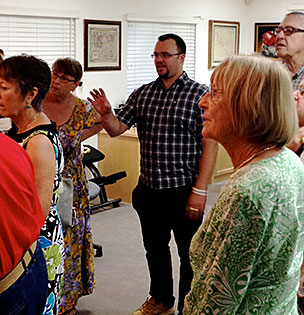 |
| Will Larson, above, answers questions at Pala International last Saturday during a visit by members of the Gem & Mineral Council of the Natural History Museum of Los Angeles. Below, master gem and mineral photographer (and Council board member) Erica Van Pelt. Hosted by Pala were over 60 members including Eloïse Gaillou, the museum’s Associate Curator of Mineral Sciences. (Photos: Geri Vigil, The Collector Fine Jewelry) |
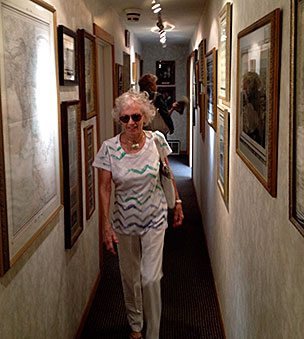 |
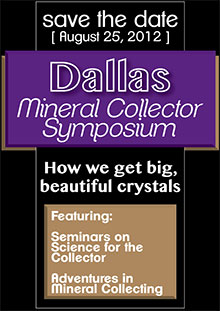 |
The theme of this year’s symposium is “Expeditions to Bring Out Mineral Specimens from Around the World.” Pala’s Bill Larson will present on “Burma’s Ancient Valley of Gems and Rubies,” regarding travels to the source in Mogok. Herb Obodda will discuss “Dangerous Beauty: Minerals of the Hindu Kush,” regarding the opening of Afghanistan and Pakistan for mineral specimens, 1969–present. Mineral cleaning and preparation technology will be handled by Jon Voelter. Rock Currier will look at “Exploring the Mines of Dal’negorsk, Siberia,” and Les Presmyk will discuss “Bisbee, Arizona: History, Significance and Treasures.”
Two sessions will address “Science for the Collector.” Dr. David London, of the University of Oklahoma, will speak on “Gem-Forming Pegmatites: How Nature Makes Big, Clear Crystals.” Dr. Peter Megaw, president of IMDEX/Cascabel, will present on “Formation of Open Pockets of Collectible Crystals in Carbonate Replacement Deposits – Tsumeb , Dal’negorsk and Milpillas.”
Seating is limited, so see the symposium website for details. It will be held at the Edwin L. Cox School of Business on the campus of Southern Methodist University. An evening gallery event will be hosted by The Arkenstone.
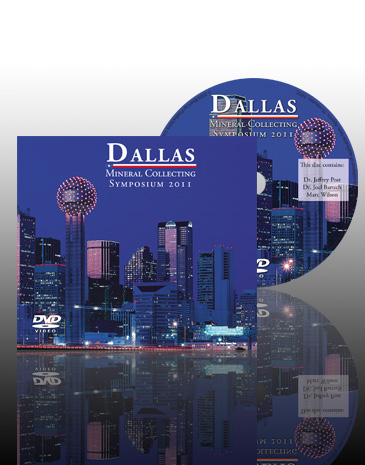 |
| Last year’s symposium featured luminaries from seven institutions from across the country. It’s available from BlueCap Productions. To receive a 10% discount, just enter the code palaintl when you’re asked for it while ordering. What’s Hot In Tucson 2012 and What’s Hot In Munich 2011 also are available. Click images below for more info. |
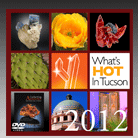  |
[back to top]
The 28th Intergem show will be held October 5–8 in Idar-Oberstein, Germany. A pre-show press release claims expectations that the show should be “excellent… since the gemstone market has strongly recovered.” Local dealer Constantin Wild was quoted: “Coloured gemstones are becoming rarer each day, selling stones is easier than buying at the moment.” Blamed for the shortage is the closure of mines and cessation of exploration during the economic crisis.
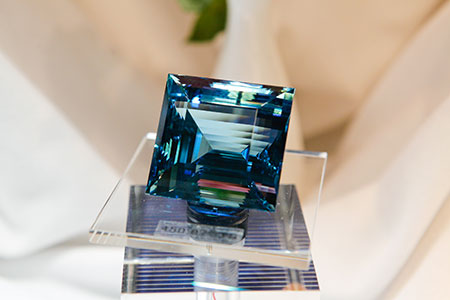 |
| (Photo: Herbert Piel, PIELmedia, courtesy of Intergem) |
[back to top]
It’s time again for the third biennial World of Gems Conference, to be held October 13–14 at the Intercontinental O’Hare hotel in the Chicago area. The conference is hosted by Gemworld International, publisher of the gem-pricing authority, The Gem Guide.
Slated topics include corundum treatment levels, padparadscha sapphire, gemological qualities of garnet, gemstone nomenclature and more. Presenters include Christopher Smith, John Emmett, Shane McClure, Brendan Laurs, Alan Hodgkinson, Jack Ogden, Mary Johnson, Gary Roskin, Richard Drucker, Stuart Robertson and Cigdem Lule.
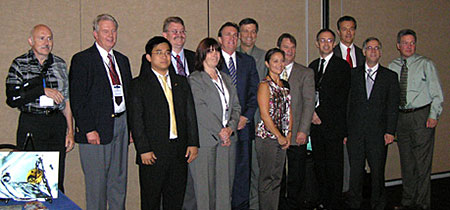 |
| Speakers 2008, L–R: John Koivula, Dr. James Shigley, Hpone-Phyo K. Nyunt, Paul Shannon, Dr. Lore Kiefert, Robert Kane, Richard Drucker, Gina Latendresse, Eric Braunwart, Christopher Smith, Ron Ringsrud, Gary Roskin and Stuart Robertson. (Photo: Elise Skalwold; see her report from the 2008 conference) |
Post-conference books containing the proceedings for both 2008 and 2010 are available on the conference home page. [back to top]
The first Pakistan International Gems & Jewellery Exhibition, which originally was to be staged two years ago this month, was finally held June 7–10 of this year, in Karachi. (Postponement was due to massive flooding in late June 2010.) Sponsored by the Pakistan Gems and Jewellery Development Company, this B2B show was inaugurated by to-be-ousted Prime Minister Raza Gillani. According to the show website, in attendance were “55 foreign buyers and delegates from India, U.A.E, U.K, Sri Lanka, Hong Kong, Germany and France….” On the 9th, the International Colored Gemstone Association and others presented a seminar.
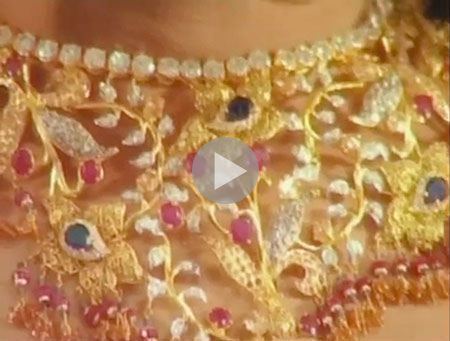 |
| This five-minute documentary provides a high-level overview of the Pakistan gems and jewelry industry. |
Uncaptioned photos from the exhibition are posted here. The show brochure contains a nice overview of the gems, jewelry and mineral industries, including the list, “Gemstones Occurrence in Pakistan.” Statistics included in the brochure:
In March of this year, the prime minister took steps to increase the export level of gems and jewelry to $5.5 billion by FY 2016–17, according to the daily Dawn. The daily reported in May that these exports amounted to $1.5 billion between FY 2007 and FY 2011, with a projected total of $800 million for 2012. An undated report (likely 2009) stated that the exports for FY 2004–05 were at $23 million and in 2006–07 moved up to $47 million. The next year they had climbed four-fold, to $210.86 million, moving to only $240 million in FY 2008–09.
That same undated story claimed (again, likely in 2009) that the relatively recent organization of Gems Bazaars held promise, but were not attracting foreign buyers, who felt they received “much better” value at similar venues in China. The permanent Gem Exchange, in Peshawar’s Namak Mandi area, was “as good as dead” due to high rents and lack of foreigners.
The following item came to us yesterday, courtesy of G&G eBrief, GIA’s monthly missive sent to news editors from Gems & Gemology.
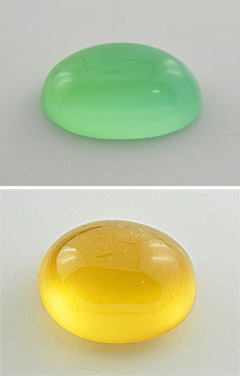 |
| These green and orangy yellow cabochons (16.77 and 32.06 ct, respectively) proved to be calcite, reportedly mined from Pakistan’s Baluchistan province. (Photos: G. Choudhary courtesy GIA) |
Mehul Durlabhji, co-convener of the Gem Testing Laboratory of Jaipur, India, recently brought two cabochons to this contributor for identification. The specimens, one green and one orangy yellow, were obtained from a dealer in Pakistan who said that large quantities were being mined in the southwest province of Baluchistan. At first glance, both resembled opal or chalcedony, but gemological and spectroscopic testing proved otherwise.
The green cabochon weighed 16.77 ct, while the orangy yellow stone was 32.06 ct. Both had a spot RI of ~1.56, with the large birefringence blink typically seen in carbonate minerals, and a hydrostatic SG of 2.72. The orangy yellow cabochon fluoresced yellow to long- and short-wave UV radiation, while the green sample was inert. No absorption features were seen in either stone with a desk-model spectroscope. While observing the stones in various directions under a lamp, banding was seen along their length, indicating a layered growth. These bands were quite prominent and widely spaced, unlike those seen in chalcedony. At higher magnification, fine acicular to fibrous inclusions oriented perpendicular to the direction of banding were visible. These are consistent with the presence of compact masses of fine acicular crystals, similar to those in “satin-spar,” the term used for a variety of gypsum with parallel fibrous crystals.
FTIR spectroscopy revealed two bands at around 4520–4200 cm–1 and 4150–3870 cm–1, as well as complete absorption to 3750 cm–1. These features are characteristic of carbonate minerals (e.g., calcite). Qualitative EDXRF analysis of both cabochons revealed the presence of Ca (as expected for calcite), as well as trace Cu and Mn in the green sample and trace Sr in the orangy yellow one. Identification of these calcite varieties is straightforward using standard gemological techniques. Despite their low hardness, they add to Pakistan’s wide range of available gem materials.
—Gagan Choudhary
Gem Testing Laboratory, Jaipur, India
[back to top]
This month we feature some colorful free-form cabochons with a mix of azurite and malachite. This material was mined pre-1960s from Bisbee, Arizona, and purchased years ago by Pala International as specimens, then cut more recently by Bud Standley. Similar specimens have been mined in Morenci, AZ, and more recently at the Milpillas Mine in Sonora, Mexico.
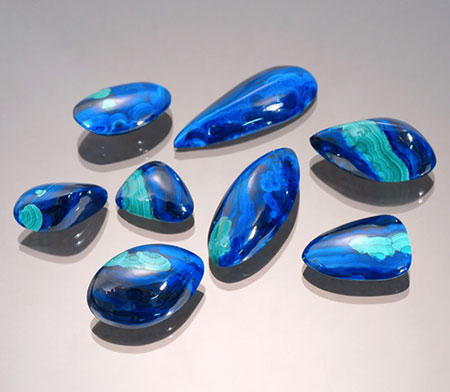 |
| Azurite-Malachite. Various shapes and sizes. For reference the bullet shaped stone at lower right is 11 ct, 18.66 x 14 x 5.11 mm, Inventory #16149. Click to enlarge. (Photo: Wimon Manorotkul) |
The material features intricate flow and growth patterns, bands of alternating dark and light blues and greens. And brilliant cornflower to cobalt-blue azurite showing some bullseye patterns left after botriyoidal formations have been cross-cut and polished. Then, as if bubbling right out of the blue, radiating bands of malachite create an exquisite contrast. Two copper minerals are blended together to make a truly unique and beautiful gem.
Pala International has an extensive selection of azurite and malachite in specimens, rough, cabochons and free-form.
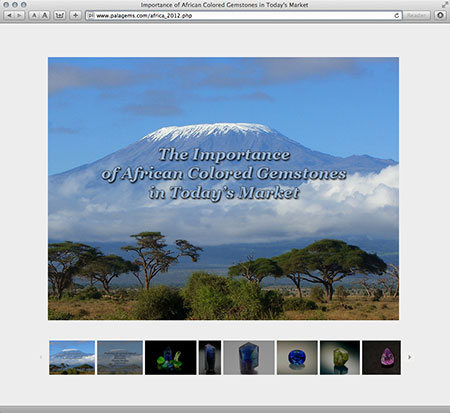 |
| Note: Beginning with the third slide, click the boxed “i” to view captions. |
In April, Pala International’s Bill Larson delivered a keynote address to The Arusha International Gem, Jewelry and Minerals Fair, held in Arusha, Tanzania. The subject was “The Importance of African Colored Gemstones in Today’s Market.” We’ve turned Bill’s PowerPoint presentation into an online slide show for your viewing pleasure.
While in Tanzania for the Arusha show, Will Larson toured the local tanzanite mines, video camera in hand. He visited the TanzaniteOne mine in “Block C” as well as two mines in “Block D.” The resulting video, First Voyage to Tanzania – Tanzanite – A Stone of Beauty, inaugurates Pala International’s YouTube channel, available here.
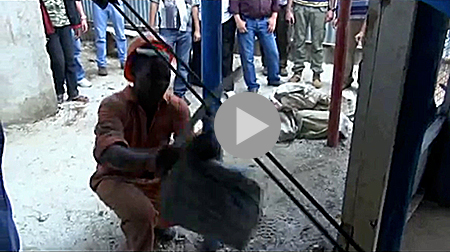 |
| A worker in a Block D mine uses a machete to cut a bag of rough from a pulley cable as bag after bag reaches the surface. |
See also Will Larson’s written report on the Arusha show and visits to the mines, on Palagems.com.
Robert Weldon, GIA Manager of Photography & Visual Communications, also attended the show in Arusha. He reflects on the gem fair in “Add Value to East Africa Gems and People Will Shine, Too.” While discussing the challenges facing the region around Arusha with some of the principal players, Weldon weaves in the story of an individual gem trader, Miriam Kamau, based in Kenya, who is now International Colored Gemstone Association’s Kenyan ambassador.
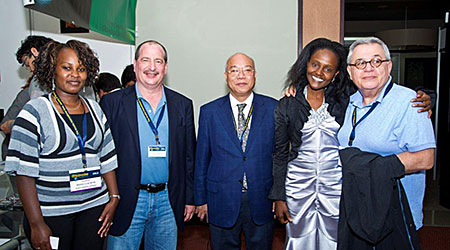 |
| Delegates and exhibitors paused for a photo at the Arusha International Gem and Mineral Fair. From left, Monica Gichuhi, CEO of the Kenya Chamber of Mines; gem dealer Evan Caplan; President of the International Colored Gemstone Association, Wilson Yuen; gem dealer Miriam Kamau; and gem dealer Benjamin Hackman. (Photo: Robert Weldon, © GIA 2012) |
GIA’s presence at Arusha, related by Weldon’s moving report, is one element of a larger effort by GIA to offer gemological education and resources to gemstone-producing communities.
The Gemmological Association of Australia is sponsoring a two-week “Tanzanian Gem Safari” October 9–22, 2012. Several mines will be visited, including tanzanite, diamond, ruby, gold and alexandrite.
The Summer 2012 edition of Gems & Gemology includes an article that is available onlne: “Champagne/Imperial Garnet from Lindi Province, Tanzania.” [back to top]
SSEF, the Swiss Gemmological Institute, which last year introduced its GemExplorer iPhone app, has now taken it to the World Wide Web. You can browse by type of gemstone or continent. You can mouseover virtual push-pins on a world map to get locality/gemstone and mine information. Visit the GemExplorer website.
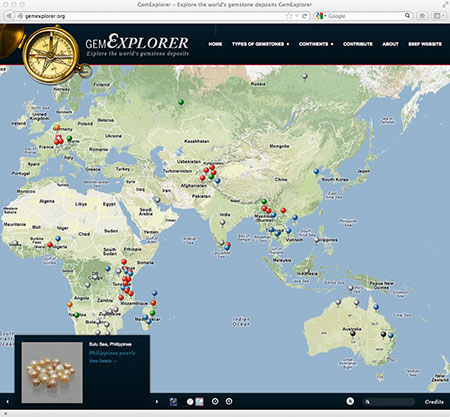 |
 |
| This lovely 1.04-carat haüyne is in a size more commonly seen for such a rare variety. Inventory #17308. (Photo: Mia Dixon) |
The Gem and Jewelry Institute of Thailand (GIT) issued two recent reports. “The Artificial Blue Glass Sold as Rare Gemstone ‘Haüyne’” concerns two sky-blue gemstones sold as haüyne. The mixed cut stone weighed 6.11 carats—pretty hefty for a stone that usually weighs in at less than a carat.
Physical inspection was inconclusive, and actually pointed towards haüyne, but Raman spectra left no doubt that the material was artificial glass with some interesting characteristics, outlined in the report.
Earlier this year, two other blue stones came into the lab, claiming to be heat-treated sapphires. This time physical inspection revealed telltale signs of glass filler, including color concentrations, unhealed fractures, bubbles and yellow/blue/pink flash effect. Unfortunately, the stones were sold as being only “conventionally or traditionally heated.” Read the report, “Blue Dyed and Clarity Modified Sapphire with Cobalt+Lead-Glass Filler in Fractures and Cavities.”
Prof. H. A. Hänni, who along with Prof. Johannes Hunziker make up the consulting firm GemExpert, has archived some of his gemological writing on the firm’s website. While at SSEF in 2008, Dr. Hänni produced a report on jambolite from Tanzania, which caught our eye. The blue areas of the unidentified material resembled lapis lazuli; green areas resembled chrysocolla. Fractures and cleavage planes, under weak magnification, indicated filler.
The material turned out to be natural but yet unnamed. Dr. Hänni: “Jambolite was proposed as a trade name, a welcome solution considering the complex mineralogical situation and the fact that there is no precedence of similar ornamental material already named.” Read “Jambolite - A natural impregnation of a rock by copper minerals.”
Abstracts of two articles from Gem-A’s journal are available. D. P. Cronin and A. M. Rendle write on using energy dispersive X-ray spectroscopy to nondestructively determine geographical point of origin (GPO) in emerald samples from six distinct GPOs. It worked: the compositional diversity was readily apparent, thus suggesting individual GPOs.
The second article, by S. A. Ananyev and S. I. Konovalenko, looks at spinel from the Goron deposit, southwestern Pamirs, Tajikistan.
    |
| Four hues of pink spinel from Tajikistan. Click each image for details. (Photos clockwise from upper left: 1/4 Mia Dixon, 2/3 Wimon Manorotkul.) |
The French website Geminterest.com has some material in English, and some of the French-language items are fairly easily transliterated. There are reprinted articles and brief reports called “FlashData” sheets. And you can always use a web translation tool like this.
 |
| This screenshot is taken from the translated “FlashData” PDF on conch pearl, from Geminterest.com. |
[back to top]
Last month’s GIA Insider e-newsletter included a fairly detailed summary of a talk given by Vincent Pardieu to students and staff at GIA’s Carlsbad campus. Pardieu is supervisor of field gemology at GIA Laboratory Bangkok, so it was appropriate that his presentation included not only accounts of his worldwide travels to gemstone-producing localities, but also tips on approaches to safely navigate the environs.
Readers of our newsletter will recall Pardieu’s September 2009 attempt to visit the ruby mines of Niassa Province in northern Mozambique. Pardieu’s party had a “misunderstanding” that led to their arrest and three days’ detention. And an earlier expedition, from which the photo below was taken, had his party breaking bread with veteran Mujahideen who had fought against the Soviets in the 1980s. These fighters just happened to be intimately involved in Panjshir emerald mining.
So it’s a tricky business, but one that thrives to a certain extent on business—brought by foreigners. Read the entire presentation summary here.
 |
| Vincent Pardieu, center, in the Kalat mining area of eastern Afghanistan, 2006. Read the full account of this expedition here. (Photo courtesy Vincent Pardieu, Fieldgemology.org) |
[back to top]
Bloomberg TV’s Susan Li recently asked the question, “Are Diamonds Now an Investor’s Best Friend?” After looking at the poor performance over the last year of diamonds (down 20%) compared with the markets of gold, equities and property, she looked at a BMO Capital Markets projection of 3% rise in 2013 and 5–7% in 2014 onwards. She then spoke with Shlomo Tidhar, Acting CEO of the Singapore Diamond Exchange, who admitted that diamond liquidity for investors is in contrast to other markets, but the outlook remains bright for diamonds as an investment choice. See the video here.
GIA Senior Industry Analyst Russell Shor wrote last month, noting an 8% drop in diamond prices since April (per Harry Winston). He mentions that the Diamond Trading Company clients at the July sight were expected to defer at least 50% of their allocations, for as much as eight months. June’s deferment was perhaps as large. Shor discusses other details of the market as well.
Later this month, in its “Diamond Rush” documentary CNBC travels to Botswana and DeBeers’s “crown jewel” diamond mine (that would be Jwaneng) before heading off to Las Vegas and the jewelry show there. Next, the Diamond Dealers Club on New York’s 47th Street allows cameras in for the first time. Rounding out this tour is a visit to Arkansas. The Crater of Diamonds State Park, in southwestern Arkansas, has a multi-acre prospecting area, which has brought diamondista Glenn Worthington of Murfreesboro some stunning successes.
 |
| It has risen! Glenn Worthington unearthed the “Easter Sunrise Diamond” just before shutting down for the holiday weekend. He and his wife Cindy don’t plan to cut it. (Photo: Glenn Worthington) |
On April 9, 2009, Worthington found the 2.04-carat yellow diamond pictured above, which Worthington, a devout Christian, named the “Easter Sunrise Diamond.” It was, truth be told, found on Maundy Thursday, but who can quibble when you’re in possession of a beauty like that? It is the second largest he has found.
The largest diamond uncovered by Worthington in about 32 years of searching came less than a year later, on February 18—and, no, it was not dubbed the “Presidents Day Diamond.” The color and shape lent itself to be known as the “Brown Rice Diamond.” But once faceted, at 1.21 carats it sparkled.
 |
| Sans bran. The “Brown Rice Diamond” at left is shown in its faceted state, next to the “Easter Sunrise Diamond.” (Photo: Glenn Worthington) |
See “Crater News” for more photos of these and other diamonds, and for much detail on their discovery. Worthington tells us that he updates his Facebook page every day with news of the new finds. See also Wikipedia for a list of notable diamonds found at the site. [back to top]
 |
Former print publisher F+W Media, which moved into the new media arena, has acquired the parent company of Interweave, publisher of Lapidary Journal Jewelry Artist, and 15 other jewelry and craft magazines. The magazine now will have access to the new owner’s 20+ e-commerce stores and other plans in the works, according to a July 31 press release.
Interweave was the publisher of Colored Stone before its demise in 2010. A searchable CD archive of the 2009–2010 editions is still available at a reduced rate. [back to top]
We normally reserve these sort of items for our bimonthly sister e-publication, Pala Mineralis, but we couldn’t resist getting them out to our dual-subscribers before October.
The University of Arizona has a thriving mineralogy program, and is host to the RRUFF Project, an integrated database of Raman spectra, X-ray diffraction and chemistry data for minerals. Two UA geoscientists also are involved in NASA’s Curiosity rover. Prof. Bob Downs and graduate student Shaunna Morrison are “primary data downlink leaders,” members of a team charged with IDing the minerals that come Curiosity’s way on its two-year journey on Mars. Read all about the high technology behind the project here.
 |
The Weardale Giant is the name given to a huge fluorite specimen uncovered recently in the Weardale mining district of northern England. It is also the name given to the legendary giants of the area, the blacksmiths Mug, Con and Ben, who could afford but one hammer between them. As they forged swords, they tossed the hammer back and forth, mindful of the curse upon them: if the hammer were to be dropped, they would vanish. It was Mug whose eyesight faltered along with his grasp; the hammer left a deep rift, now known as the Howden Valley.
 |
| Just a trim in back, please. The Weardale Giant is relieved of heavy matrix with a diamond saw to make it lighter for transport. (Photo courtesy Cal Graeber and Jesse Fisher, UK Mining Ventures) |
But back to the specimen. The “Giant” was so big—likely half a ton—it took from July 10 to August 13 in order to pry it loose and move it down ramps to the mine’s transport. Then its matrix was sawed to make it more manageable, and down the mountainside for shipment to California. With any luck it will be displayed at the Tucson Gem and Mineral Show, in perfect harmony with the 2013 theme, fluorite.
Read all about The Weardale Giant. [back to top]
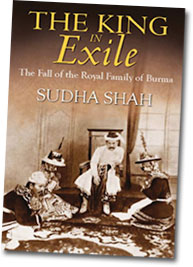 |
We are delighted to bring you a section of a new book by Sudha Shah, a writer in Mumbai, India. The King in Exile: The Fall of the Royal Family of Burma is a biography of Burma’s King Thibaw (1859–1916), chronicling the intrigue that brought him to the throne, his family’s day in the sun, and their making-do following banishment after the war with Britain in 1885.
In this passage, Shah discusses the theft or other possibilities surrounding the famous Nga Mauk ruby. A synopsis of the book follows this extract.
Extract from: The King in Exile: The Fall of the Royal Family of Burma, by Sudha Shah, pp. 76-78. Published by HarperCollins, India in June 2012
Many conflicting stories are told about the disappearance of the priceless eighty-carat Nga Mauk ruby belonging to the royal family. This ‘ruby among rubies’, apparently the size of a betel nut, was said to be ‘worth a kingdom’. [1] According to a letter written by the Second Princess in 1948, ‘the late U Po Kya, the Burmese historian, valued it at ten thousand crores of rupees at the lowest. The value of the said Nga-mauk Ruby depends not only on its weight, colour and flawlessness, but also depends on its spiritual or magnetic qualities.’ [2] According to some of King Thibaw’s ministers, on the morning of 29 November, the king handed over many valuables including the Nga Mauk ruby ring to Colonel Sladen for safekeeping. [3]
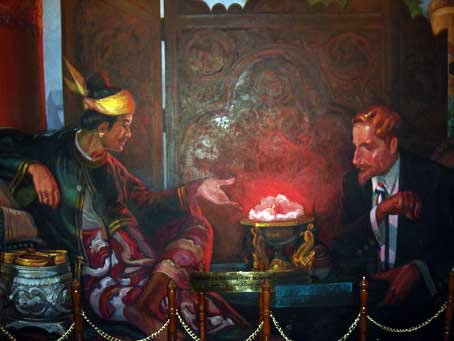 |
| “Awed by the Fabulous Ruby Nga Mauk.” An inquiry by author Sudha Shah to Pala International regarding this painting led to our reprint of the present extract. The painting depicts King Thibaw showing the royal ruby to gem merchant extraordinaire and author Edwin Streeter. For an account of the ruby trade written 15 years after the death of Thibaw, see “Fire-Hearted Pebbles from Burma” by C.M. Enriquez. (Photo: Bill Larson) |
When Sladen was later questioned by letter about the ruby, he wrote that he had no recollection of the ring. There was just too much confusion, he wrote: ‘the Palace was being overrun by crowds of common women who were looting in all directions and carrying away boxes and bundles . . .’ The king and queen were in a state of ‘great grief and trepidation’, and had to be quickly moved to the Summer Pavilion. Sladen said that after the couple were in the pavilion,
[their] attendants were busy removing Royal baggage, consisting of numerous boxes and bundles, from the Palace—it is impossible to say whether any or what portion of the Regalia may have been taken away at this time, or during the previous night when most of the minor Queens and Princesses and some 300 maids of honour are known to have made good their departure! [4]
A correspondent of The Times (London) who interviewed King Thibaw on the morning of his exile, after he was in the Summer Pavilion, noticed the king had on ‘a magnificent ruby ring’. [5] Was this the Nga Mauk? The king’s daughter, the Fourth Princess, states in a missive that when her parents were leaving Mandalay ‘the priceless Crown Ruby’ was ‘in their betel-box. Sladen asked my parents to let him have a look at it and they gave it to him. My parents said that after looking at it for a while, Sladen put it into his pocket, and pretending to be absentminded, did not return it.’ [6] One of the Fourth Princess’s sons believes that Colonel Sladen carried the Nga Mauk ruby back to England, and it is perhaps now part of the British Crown Jewels. Perhaps it has been re-cut and re-set. Many valuables forming part of the regalia were sent to Britain—a piece or two to Queen Victoria, and the vast majority to the South Kensington Museum (now the Victoria and Albert Museum). [7]
U Than Swe has a different take on the disappearance of the Nga Mauk ruby. He believes that King Thibaw probably gifted it to Colonel Sladen ‘to ensure their future’. He argues that when a man as desperate and frightened as King Thibaw was at the time is pushed into such a tight corner and is bargaining for his life and that of his family, wouldn’t he give up his most precious possession to someone whom he believes has a great say on what is to become of him? So when Colonel Sladen asked to have a look at the Nga Mauk ruby, and hesitated to return it, the king told him to keep it. [8] Sladen’s 1885 handwritten diary today lies in the British Library in London. A significant portion of a 29 November 1885 entry has been thoroughly blackened out, making one wonder what it was that he recorded that day that he wanted so completely and totally obliterated (other entries in this diary needing deletion have been crossed out with just a simple line). [9]
In 1879, as the king of Burma lay dying, one of his queens schemed for his forty-first son, Thibaw, to supersede his half brothers to the throne. For seven years, King Thibaw and Queen Supayalat ruled from the resplendent, intrigue-infused Golden Palace in Mandalay, where they were treated as demi-gods. After a war against Britain in 1885, their kingdom was lost, and the family exiled to the secluded town of Ratnagiri in British-occupied India. Here they lived, closely guarded, for over thirty-one years. The king's four daughters received almost no education, and their social interaction was restricted mainly to their staff. As the princesses grew, so did their hopes and frustrations. Two of them fell in love with 'highly inappropriate' men. In 1916, the heartbroken king died. Queen Supayalat and her daughters were permitted to return to Rangoon in 1919. In Burma, the old queen regained some of her feisty spirit as visitors came by daily to pay their respects. All the princesses, however, had to make numerous adjustments in a world they had no knowledge of. The impact of the deposition and exile echoed forever in each of their lives, as it did in the lives of their children.
Award-winning novelist Amitav Ghosh gave a telling assessment of the book, excerpted from her blog:
An absorbing read. Exhaustively researched and gracefully written The King in Exile tells a story of compelling human interest, filled with drama, pathos and tragedy... [It] heralds the arrival of a writer of non-fiction who is both uncommonly talented and exceptionally diligent... One of the great merits of [the book] is that it is completely free of jargon and theorizing. It is in essence a family story, centred on five women whose lives were waylaid by history’.
See more about the book on the HarperCollins Publishers India website. [back to top]
— End August Newsletter • Published 8/17/12 —
In this edition of our newsletter we feature some scrumptious Brazilian tourmaline prior to our trip to the JA New York Summer Show, at which you’ll be able to see stock like this in person. We point to a new online museum and look at museum-worthy treasures. We look at Wikiwars, looming emerald wars and de-facto civil wars near and far.
Pala International heads to the East Coast later this summer for the trade-only JA New York Summer Show. Stop by to see one of America’s largest selections of fine colored gems.
 |
See this list of seminars to be held at the show.
When: July 29–July 31, 2012
Where: Jacob K. Javits Convention Center
Hours: AGTA Gemstone Section
Sunday, July 29: 10:00 AM – 6:00 PM – New Start Time
Monday, July 25: 10:00 AM – 6:00 PM
Tuesday, July 26: 10:00 AM – 4:00 PM – New End Time
Pala International is in booth 2581. See the JANY website for more information. Visit the Pala International Show Schedule for future events. [back to top]
This month we feature a couple of complimentary tourmalines in the teal spectrum. Tourmalines have been a jewel of interest for at least half a millennium, being mined all around the globe in every color imaginable. The range of colors, big sizes and clean nature has made tourmaline a staple of gem and jewelry connoisseurs worldwide.
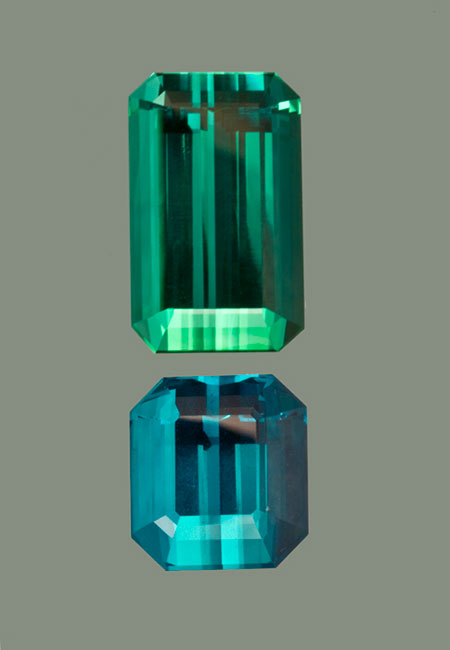 |
| Teal Tourmaline: 24.05-ct blue-green emerald cut, 20 x 12.1 x 10.5 mm, Inv. #20351; 15.49-ct indicolite emerald cut, 14.23 x 12.95 x 10.5 8mm, Inv. #15993. (Photo Mia Dixon) |
These two emerald-cut beauties seem to mix well with the teal green and teal blue hues exhibiting aquatic tones. The green one was a recent purchase from Brazil and the indicolite has been in inventory for a few years, most likely from Brazil as well.
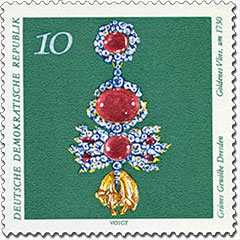 |
| Jewelled insignia of the Order of the Golden Fleece, 1730, housed in Dresden’s Grünes Gewölbe (Green Vault), repository of more than 4,000 items of treasure. (Image courtesy Dr. R. Shah) |
Late last month, Dr. Rajnikant Shah unveiled a virtual museum devoted to postage stamps of gemstones, minerals, jewelry, clocks, coins, and gold and silver. The museum database has over 10,000 items. Visitors can easily filter down to an area of particular interest. A search function also is available.
According to the website, Dr. Shah began collecting at school in Jaipur, India, in the year of the country’s independence, 1947. The first stamps came from his parents, who lived in Burma. Thirty years later, he found himself in the United States in his family’s profession: gemstones. The travel that the business required gave him access to stamps from a variety of countries. In his choice of philatelic themes, he brought together his hobby with his profession.
Visit Dr. Shah’s Gem & Jewelry Stamp Museum here.
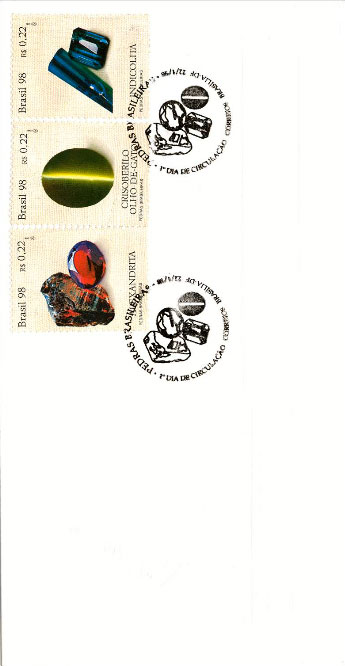 |
| From Brazil, this meter-marked first day cover features stamps depicting alexandrite, cat’s eye chrysoberyl and indicolite. (Image courtesy Dr. R. Shah) |
[back to top]
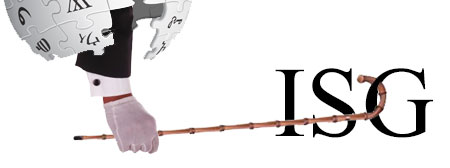 |
Every once in a great while you run across a Wikipedia entry in dispute. Take Bhagwan Shree Rajneesh, the late Indian guru whose mashup of ancient traditions drew devotees in droves. A recently screened 2010 documentary, Guru: Bhagwan, His Secretary & His Bodyguard, lays out in detail how otherwise spirit-loving people became ideologically driven to steamroll all resistance to the guru and his colony in Oregon, prior to his deportation.
But even the deceased and discredited can maintain devotees. On Wikipedia we expected to see a struggle between the Bhagwan’s faithful few and naysayers, with Wikipedia’s referees in the middle. While the 30-page Rajneesh entry has a lot of behind-the-scenes discussion and debate, there’s little sign of turmoil.
Not so for a gemology-related entry that was terminally turmoiled—and we’re not talking about andesine (the entry for which is plain sleepy), but there is a connection. Last week, gemologist Robert James, who has devoted three websites to the red andesine controversy, had the Wikipedia entry pulled for his San Antonio-based International School of Gemology (ISG). The page experienced so many edits, both by critics and ISG partisans, that it was dropped by Wikipedia gatekeepers.
We visited the ISG entry a few days prior to its demise (see cached version here). First, you have to look past three color-coded warnings (à la Homeland Security Advisory System). Quite a bit of fuss for a distance learning institution.
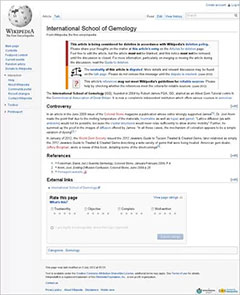 |
Moving on, the introduction explains that the school was founded by James in 2004 and that it had its roots in Gem-A before going it alone. Next, a section titled Controversy contains two items, but without any introductory context regarding the controversy, which would baffle some readers. The first item refers to a June 2009 critique by Dr. Joel Arem in Colored Stone of James’s take on diffusion versus dyeing. Second, citation of a review of 2012 Jewelers Guide to Treated & Created Gems, issued by the World Gem Society (WGS), but omitting that WGS is a late-2011 adjunct to ISG. (Elsewhere, James pointed out that the review’s author, Jeffrey Bergman, actually was a “competitor,” given his status as VP of the similarly-named International Gem Society, founded in 1998.) Again, with no context for WGS’s inclusion in the ISG entry, the uninitiated visitor is left feeling like something was missing. We decided to take a look under the hood, beginning with History, which documented the hundreds of edits the page had endured.
The page was created on May 3, 2007 by “Robert The Jeweler.” While there are myriad jewelers named Robert, it’s of interest that, regardless of identity, the impression is that it was James himself who authored the page. This is notable because one of the Wikipedia no-no’s is self-promotion, while at the same time the Wikipedia community values notions like “Ignore all rules.”
Leaving aside the issue of who was doing the promoting, the 5/3/07 version was very brief, stating among other things that the school was a member of AGTA and Polygon. In September 2009, James announced that ISG was leaving Polygon due to an unnamed fraud concern, but the school website speaks of membership currently. The same can’t be said for AGTA, with that bridge burned well before October 2009 when James called the AGTA’s Tucson GemFair “the ghost town of the Tucson Gem Shows” following CEO Doug Hucker’s call for a convention center upgrade. What wasn’t a ghost town was the ISG student body on 5/3/07: 1200 students from 51 countries. (In the ISG forum’s articles section, we counted the names of 129 students who were given diplomas and/or certificates between March 16, 2011 and the same date in 2012.)
In late August of 2007, ISG courses were added to the entry, complete with tuition fees. A year later, an editor IDed the school as being a United Kingdom university, presumably due to the Gem-A reference. December 2008 saw the first mention of andesine, in reference to a September 2008 Colored Stone article on ISG’s report of copper diffusion of andesine. (James contends to the present day that sources of natural red andesine in China do not exist, and that all visited localities of production have been “salted,” a ruse, he says, that producers have had years during which to accomplish prior to visits.)
That’s as far as we got before the ISG page and most of the documentation was removed on July 8. The reason proposed for the deletion, and then adopted: “No reliable sources can be found. Article is being used as a WP:COATRACK to attack the subject.” In other words, the subject of ISG (coat rack) was being obscured by edits (coats, hats) made by James’s critics, who often cited online forums, which the gatekeepers considered off-limits as supporting documentation. During the last days of the page, on June 14, James took Wikipedia itself to task, stating that the website and its operation pose a threat to the Internet. James claimed that prior to the edits, the page was written by ISG graduates. He then pointed to instances on Wikipedia of cyber-bullying and malicious code. Finally, he mentioned that some critics fear that Wikipedia, by its nature of editability, is inherently unstable and unrestricted.
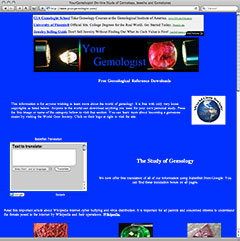 |
Apart from the Wikipedia entry, James uses several venues to advance his own critiques, that of andesine being only one. They are listed on his home page. And they have irked some in the gemological community perhaps in the same way as when a youthful Richard W. Hughes took industry conventions to task years ago. (Some may recall the 1987 International Gemmological Conference in Brazil where Hughes declared that the future challenge would lie not in identifying synthetics, but rather in separating natural from treated stones, a then-radical notion that was resisted by one elder as not conforming with the CIBJO rules of the day, which required no such disclosure for “traditional” treatments like heating sapphire.) Whether James’s assertions will stand the test of time, or he has the prospect of producing a Ruby & Sapphire, is another matter.
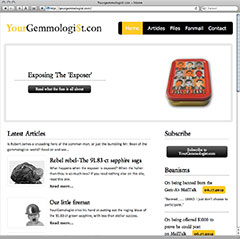 |
On June 19, not long before the demise of the ISG Wikipedia page, we received “An Open Letter to Members of the World Gem Society” from The Gobsmacked Gang, “a large group of respected gemologists and dealers on three continents dedicated to gemological integrity and full disclosure of all treatments.” Fearing retaliatory cyber-bullying by James, they remain anonymous, but in a postscript to his June 20 reply, James lashed out at gemologist “Richard W. Hughes and your ‘Group,’” whom he suspects to be behind The Gobsmacked Gang.
The open letter boldly asks WGS members to cancel their memberships. (James, in turn, followed up ten days later with an email welcoming 21 new members.) The letter points to a new website that has begun the task of countering James’s assertions. While the open letter is dryly straightforward, with perhaps the hint of a wink, the website is over the top with in-jokes that will leave James’s detractors in chuckles if not stitches, his minions less mirthful, and the rest looking for clues. Regardless, there are enough links on both these websites for weaders—er, readers—to be brought into the loop. [back to top]
Last week, The Hindu reported in some detail on the contents and inventory process of Vault A of Shree Padmanabhaswamy Temple, in which much treasure was discovered a year ago in the Indian state of Kerala. The items are being inventoried by experts under the scrutiny of closed circuit TV and documented electronically by employees of Kerala’s own Keltron (Kerala Electronics Development Corporation Limited), which operates under the state government.
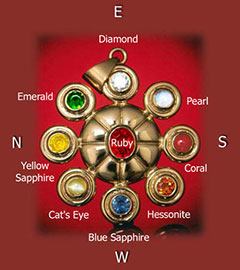 |
| See this explanation of the attributes of the gemstones in the Navaratna. (Image courtesy Rsbj66 via Wikipedia Commons) |
Last week’s article re-lists the contents that were announced a year ago: rubies and emeralds, diamonds (some Belgium diamonds), gold objects including plates and staffs, and three gold crowns. Last year, India Today mentioned 2,000 diamond-studded gold chains; last week’s Hindu article counts 1,200 sarappoli mala (temple necklaces), some of which feature navaratnas. Navaratna literally is Sanskrit for nine (nava) gems (ratna), a combination that often is rendered as in the illustration at right. Other precious stones included cat’s eye.
A chain of gold coins was dated to 1732. The Travancore royals issued their own coins, which are amongst the hundreds of kilos being inventoried as well as some minted by the British East India Company, and coins from Venice, Australia and Mysore. Others come from the early 16th century reign of Krishnadeva Raya, who ruled southern India.
The inventory process is likely to take up to six months. An earlier report stated that the stock-taking of Vault D was to have been completed July 2 and that of Vault C was “all but over.” Vaults E and F contain liturgical items and will be documented when the priests find it convenient. Vault B will wait until the other vaults have been processed.
Last month The Hindu reported on a search for tunnels leading out from the temple, a possibility suggested by legend. It was felt that Vault C would need to be fortified just in case. Also in security news, Kerala police will use encrypted mobile phones for communication, and a variety of surveillance methods to protect the vaults. Defense minister A. K. Antony told reporters that the treasure is being allowed to remain at the temple because of the history of guardianship and honesty on the part of the Travancore royals.
While it can’t compare in monetary value to Kerala’s treasure (estimated in the tens of billions of dollars), a two-year-old jewelry find in northern Israel’s Tel Megiddo is nonetheless “without parallel.” Megiddo is an archaeological site overseen by Tel Aviv University (TAU), which announced on May 31 that among the jewelry discovered was an earring bearing the image of a goat (ibex) surrounded by a plait fashioned into the earring’s open, hook. TAU professors said the design is without precedent among archaeological finds, and probably dates to the 11th century BCE.
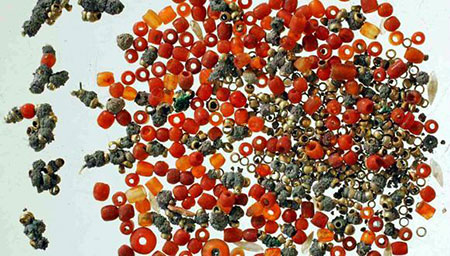 |
| TAU researchers say that these carnelian beads are evidence of an Egyptian cultural influence in Megiddo. (Photo: TAU news release) |
It appears that the earring, and beads of carnelian, gold and silver, were hidden in a ceramic jug in a private home near the palace of the region’s rulers. According to a Bloomberg story, some of the find is consistent with Egyptian designs, but this opens a question as to whether Megiddo was only a trade stop or actually was an Egyptian garrison. There likely will be more to come from Meggido, according to Bloomberg, since it is the site of 37 different cities over the centuries.
A French city in the Loire Valley wants to settle a 500-year-old grudge, and the British Crown Jewels will do nicely, thank you. The city of Angers, in what is now the départment of Maine-et-Loire, was the birthplace of 14 English kings, ruling medieval England under such names as Richard the Lionheart and Henry V. When England made its transition in 1485 from the House of Plantagenêt to the Tudor dynasty, the last Plantagenêt pretender, Edward, was kept prisoner in the Tower of London, actually affirming his title as Earl of Warwick while in prison. In 1499, Warwick was executed, ending the (legitimate) Plantagenêt line.
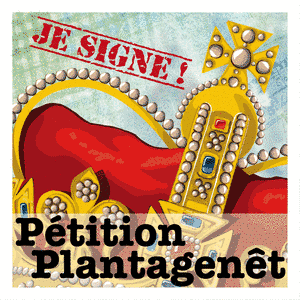 |
As reported in The Telegraph and elsewhere, hundreds of Angers citizens and others have signed a petition calling for Queen Elizabeth II to redress the killing of Warwick by giving the town the British Crown Jewels, which would be placed in the town’s Saint Aubin tower. The petition a Google translation of which follows, will be delivered to the Queen in September.
On November 28, 1499, Henry VII Tudor, [new] King of England, was beheaded in his cell [as] a young 25 year old man, imprisoned in the Tower of London since the age of 10: Edward Plantagenêt, Earl of Warwick, last direct descendant of “Angevin Kings” and [the] only one who can legitimately claim the British throne. Thus ended, [via] a state crime, three and a half centuries of reign of the Plantagenêts.
Today, the legacy of Plantagenêt must return to his heirs and the Crown Jewels of England should revert to the Angevins.
As compensation for the dispossession of the rights of the Angevin dynasty and the political assassination of his last direct descendant, the signatories of this petition demand the United Kingdom defer to Angevins, moral heirs of the Plantagenêts, the entirety of the Crown Jewels of England, which should have been legitimately revert[ed] to the Angevin kings. The Jewels, after their release, [will] be deposited in the [tower of] Saint-Aubin in Angers to be seen and kept by the population.
Blogger Tim Worstall was all for it, but only following “the union of the Angevin Empire with the United Kingdom,” as well as return of the Duchy of Normandy and Brittany. [back to top]
Emerald miner Victor Carranza emerged from the emerald wars of the 1980s as the victor, whether by default or otherwise. At the end of the decade he ingeniously enlisted the aid of the Roman Catholic Church to negotiate a peace that has maintained for the most part, despite his 1998 arrest and imprisonment for retaining a paramilitary army (and later released by the Supreme Court), a 2010 assassination attempt, and allegations this year that once again he financed militias in the 1990s. The investigations likely will be futile: Carranza has been diagnosed with cancer of both the prostate and lungs and acknowledges that his condition is terminal.
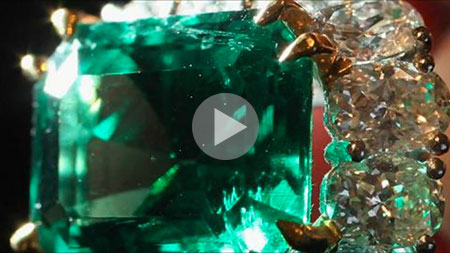 |
Peruvian journalist Fernando Lucena, based in London, has produced a short documentary that includes what may be the last interviews with Carranza. It’s a portrayal of an industry at the brink of a power vacuum that could send the mining region back in time thirty years. It’s worth watching for the humor that Carranza still is able to generate, the segments of luscious emerald and also for the above- and below-ground footage of the mining method.
Watch Colombia’s Emerald Tzar on Al Jazeera here. It’s from the “People and Power” series.
 |
| This 2.16-carat Colombian emerald (now sold) has received a common oil/resin treatment. For a discussion of how this enhancement is received in China, with nasty consequences, see Ronald Ringsrud’s emerald news. (Photo: Mia Dixon) |
On July 2, under the title “Veinte años de paz en las minas verdes” (Twenty years of peace in the green mines), we expected to read yet another deathbed durge for both Carranza and tranquility. Colombia’s daily El Espectador instead wrote of the reappearance in late June of Carranza in Otanche, in western Boyacá, home of the emerald mines. With pre-dawn fireworks and music, the entire town was celebrating the 20th anniversary of the peace deal, “a process led by the Church, which was attended by the State,” according to this Google translation. In addition to don Victor Carranza, three other dones were in attendance, but there was no question as to who was “el zar de zares.” Carranza briefly spoke.
Twenty years ago we began the task of ending the violence that generates nothing but more violence. A few did and now the process is all over western Boyacá. Colombia should imitate us.
After he left, local authorities proposed that a secretariat for peace be created for the western part of the Department of Bocayá.
Pala International has owned and sold some of the world’s finest mineral specimens. As president Bill Larson likes to muse there are no absolute criteria for what is the finest, but often a piece comes along that is certainly revered. One such is the Yamile emerald specimen. Found in the Muzo mine and named for Victor Carranza’s youngest daughter, it is now in the collection of businesswoman and philanthropist Lyda Hill, perhaps destined to grace the hall of minerals in the Dallas Museum of Nature and Science. (A merger of three Dallas museums, including the MNS, will result in a new museum, opening in January, the Perot Museum of Nature and Science.)
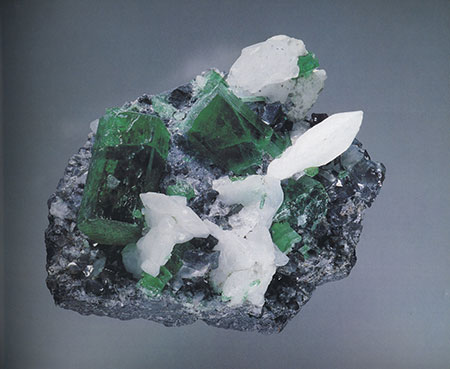 |
| Two views of the Yamile emerald mineral specimen. Above, photographed by Rodrigo Moncada from his Colombian Jewelry – History & Art. Below, photographed by Harold and Erica Van pelt, from Thompson’s Ikons. |
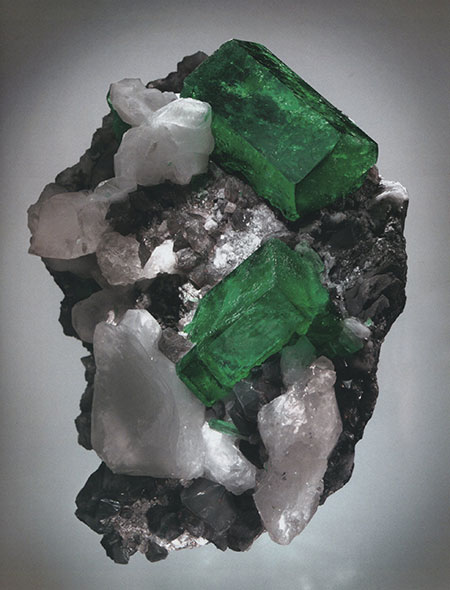 |
Pala’s involvement began with Bill Larson being shown the piece in Munich in the late 1990s. The price at that time was in the multi-millions of dollars. The interesting part for Larson was not only the two large, superb colored emerald crystals typical of Muzo, but also that the mineral specimen had been carefully removed from a pocket so that it retained perfect, large, beautiful twinned calcite crystals. Pala followed the specimen until it resurfaced a few years later, at a considerably reduced price. This time the piece was in possession of an emerald dealer who had supplied cut emeralds to Pala for years. Larson suggested a unique situation: an offer of purchasing half and leaving Carranza with 50% ownership. This deal was approved and Larson called upon his long-time friend Wayne Thompson to purchase 25%. This he did. The emerald would later be featured on page 157 in Thompson’s now-famous book Ikons: Classics and Contemporary Masterpieces of Mineralogy.
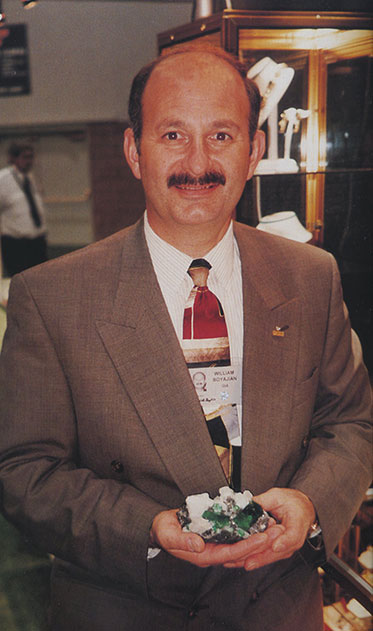 |
| Then-GIA president Bill Boyajian holds the Yamile emerald specimen. Upon seeing it, Boyajian told author-photographer Moncada that the Yamile was the finest such specimen he had seen in his life. (Photo: Rodrigo Moncada) |
Pala cleaned the specimen and had several of the broken areas trimmed to near perfection. After holding the specimen for a year, Pala sold the piece to Fine Minerals International. The profit was split among the partners. Fine Minerals took the risk and trimmed away the few remaining flaws and then later sold the specimen to Lyda Hill. Hopefully the public will be able to visit this great memory of the Muzo mines and the legend of the Emerald Czar. [back to top]
Due to a lapse in jade production in May caused by clashes in Kachin state, Burma’s annual “special sale” will not be held, according to a June 9 story by China’s Xinhua. The report stated that there are approximately 400 jade companies in Phakant area, with employees ranging from 200 to 2,000. A July overview by Agence France-Presse claimed that “jade and gold [are] at the heart of Myanmar civil war.”
 |
| Melo Melo. This pair of melo pearls from Burma is available to the public from Collector’s Corner, Inv. #17316. (Photo: Mia Dixon) |
On June 10, abut 500 business owners from several affected communities marched through Myitkyina to protest the cessation of jade and gold mining, and logging. One gem dealer said the closure was to remain in effect for five months, beginning on June 1, according to The Myanmar Times (MT).
On June 19, Kachin News Group (KNG) reported the closure of Stilwell Road in Kachin state, connecting Myitkyina with Danai. The idea was to gain control of civilian movement and strengthen military outposts in Hpakant. Fighting has been reported since May, but perhaps most troubling was the KNG report of the Burma army laying land mines. (A 17-year ceasefire ended over a year ago.)
Ten days later, KNG reported that residents of Myitkyina were plagued by rising waters of the Irrawaddy River. MT wrote that 2,100 people from nearly 400 homes were removed to five relief camps on June 25. The annual flooding is expected to be exacerbated by the presence of 75,000 internally displaced persons due to fighting between the military and the Kachin Independence Army. A portrait of life for Burma refugees in China, who are isolated from access and aid, was posted by MT on July 2. A week later, MT reported that the U.S. will provide $5 million as a result of the Kachin fighting, as well as strife at the Rakhine state–Bangladesh border. And the effect of fighting is being felt in China’s border towns, as this Associated Press story outlines. Meanwhile, Indian authorities claimed gem smuggling from Burma is on the rise, according to The Irrawaddy.
The offer of U.S. aid came before Secretary of State Hillary Rodham Clinton expressed her excitement upon meeting with Burma president U Thein Sein on July 13, two days after the U.S. gave its okay to investment in Burma. But it comes a month after Senate Republican leader Mitch McConnell had called for renewal of the import ban on Burma. Aung San Suu Kyi expressed her own ambivalence about foreign investment, during her address to the World Economic Forum. Indeed, The Irrawaddy reported that “Burma’s jade exporters are inflating property prices” in speculative action in Yangon, raising the cost of office space by 500 to 600%.
A recent, undated story by Eleven Media Group (EMG) states that a jade market in Mandalay was doing a brisk business in low-priced jade. The Mahar Aung Myay market had suffered prior to the Burmese New Year in mid-April, but since then had been making a comeback, although prices still are lower than before. Higher-priced jades are not in demand due to few Chinese buyers.
EMG also noted a June 25–27 meeting to be held between a Burma trade organization and Hong Kong business interests. The discussion was to center on “joint ventures in garment, gems and electric power sectors.” And a mining summit is set to begin Sunday in Yangon. It will feature a short presentation, “Mineral & Gem Deposits of Myanmar,” by gemologists of the Macle Gems Trade Laboratory.
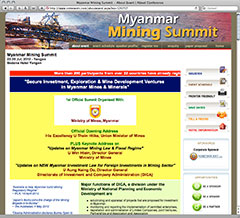 |
[back to top]
— End July Newsletter • Published 7/16/12 —
In this edition of our newsletter we feature two gemstones that come to you by way of Las Vegas; one from Sri Lanka and the other from Tanzania, site of a new gem and mineral show that Will Larson profiles. There’s plenty more to choose from, but don’t skip the new book that takes us stone by stone, jewel by jewel, through the Edward Arthur Metzger collection.
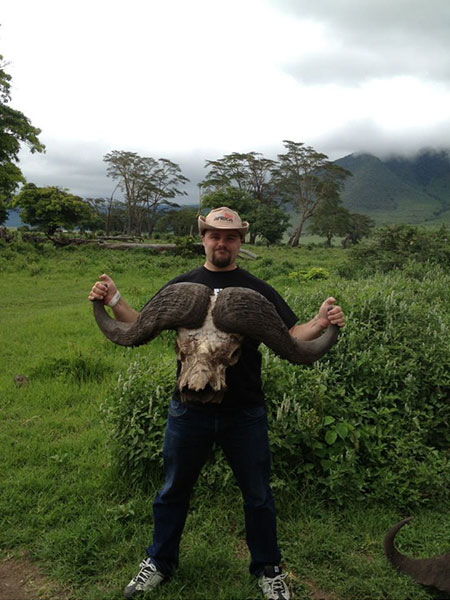 |
| That’s bull—er, Bill—er, Will. These images oddly connect two of this month’s featured stories. Above, Will Larson poses in the Ngorongoro crater area of Arusha with a cape buffalo skull. (Ngorongoro also is home to Olduvai Gorge made a household term by archaeologist Louis Leakey.) Will’s report from a recent show in Arusha begins below. Below, Bill Larson stands with Irma Vollrath who along with her late husband Claus were instrumental in assisting Edward Metzger assemble the gemstone collection that is the subject of a new book, which we review, also below. Irma stands in front of another Larson taking the bull by the horns. (Photos: Above, Bill Larson; below, Elise Skalwold; below-er, unknown) |
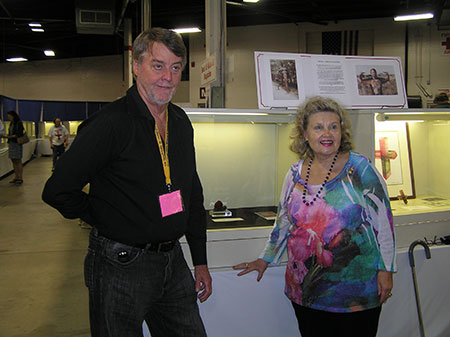 |
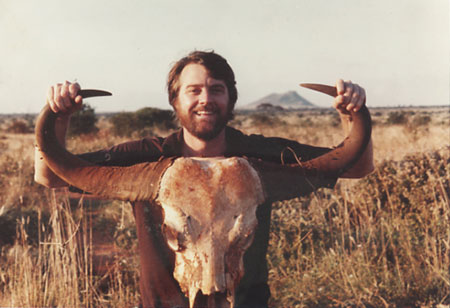 |
We highlight two shows at Orange County’s Bowers Museum.
Residents of, and visitors to, Southern California have only two weeks left to see the Bowers Museum exhibition Sacred Gold: The Prehispanic Art of Colombia. The show goes colonial, however, with the adjunct display of the Atocha Cross, which was recovered from a 17th century Spanish galleon, Nuestra Señora de Atocha, that sunk near Key West, Florida.
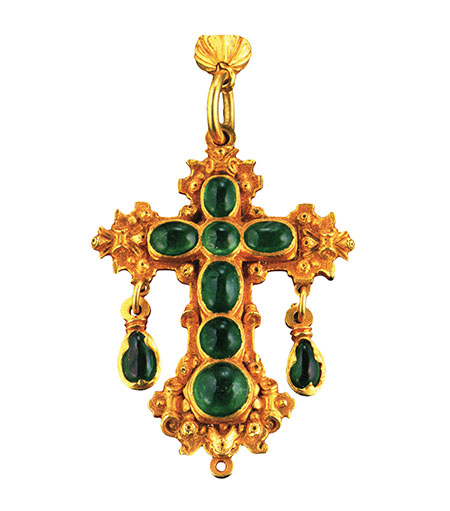 |
| Above, the Atocha Cross, featuring Colombian emeralds, which was destined for an important cleric or noble in Spain at the time of the galleon’s sinking in 1622. The reverse of the cross is decorated with engraved birds that likely were enhanced with enamel. Below, a necklace fashioned between 900 and 1600 C.E. The gold components resemble claws and were crafted using the lost wax process. The ruddy stones are unidentified. (Photos courtesy Bowers Museum) |
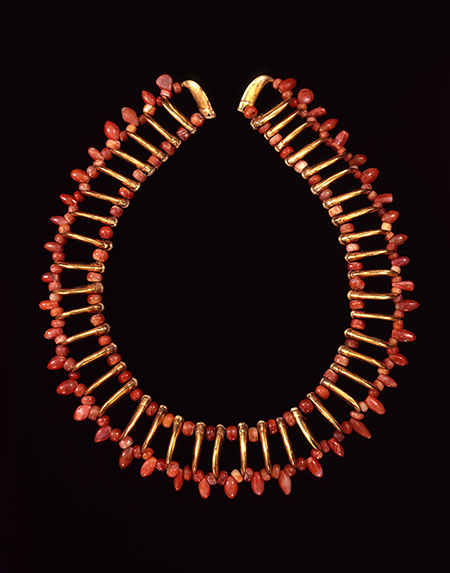 |
Sacred Gold is on loan from the Museo de Oro, which is under the direction of Colombia’s central bank. In 1939, the bank began preservation efforts for the country’s archaeological treasures. More than 200 gold figures and ornaments are displayed in the show at the Bowers, which also includes ceramic funerary figures and stone tools. See a streaming video that includes the Atocha Cross and its elaborate chain, composed of gold discs, which were caps to beads that deteriorated in the saltwater.
If you postpone your visit to the Bowers until June 23, you can catch opening day of Fabergé: Imperial Jeweler to the Tsars. Peter Carl Fabergé was born in 1846 in St. Petersburg and began a four-year goldsmithing apprenticeship in 1861 with jeweler Joseph Friedman in Frankfurt am Main. During this time, he took in the masterworks of Europe’s artists and goldsmiths, returning to Russia to work for his father, Gustav. In 1870, Carl took over the family firm and studied with the firm’s master jewelers Peter Hiskias Pendin and August Hölmstrom. During this decade, the business worked on restoring and cataloging the holdings of the Hermitage. In 1885 Carl was appointed goldsmith to the imperial crown by Tsar Alexander III. It is then he created the first of his famous imperial eggs, commissioned by the tsar as an Easter present to his wife, Tsarina Maria Feodorovna.
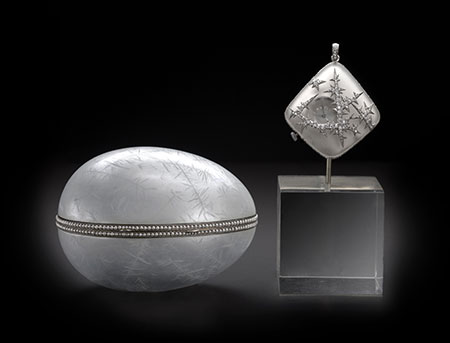 |
| The Nobel Ice Egg, was commissioned in 1913 or 1914 by its namesake, the Swedish industrialist, one of the few non-royal patrons to obtain such an objet d’art. Its jeweled and rimey exterior conceals its function as a presentation box—for the rock crystal and diamond pendant watch shown above. Such “ice jewels” designs found their way into other pieces that are included in the exhibition. Below is another presentation box, considered perhaps the finest, given by Tsar Nicholas II to French politician and statesman Leon Bourgeois, in 1902. The insignia, crafted in diamonds, is the tsar’s monogram. (Photo courtesy Bowers Museum) |
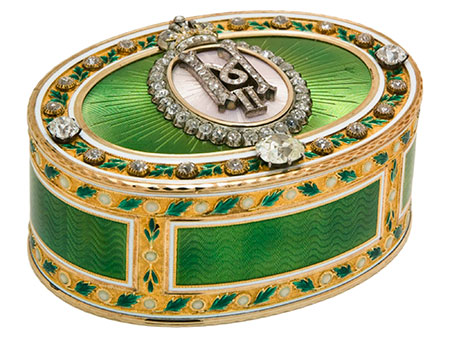 |
Unlike other exhibitions of Fabergé works, the present one comes from a single collection, the McFerrin Collection, and is the first time it has been presented to the public. Pieces from the collection have been featured in publications and exhibitions for the past 60 years.
If the Fabergé display leaves you with a yen for yolks, continue making your way down the coast to Carlsbad. Master lapidarist Dieter Jerusalem offers, in Egg-stravaganza, 850 egg-shaped gems and minerals, which he collected and carved over four decades. Hailing from impressive localities around the globe, the artist employed cutting techniques he learned in Idar-Oberstein. Each egg is an exquisite 58 mm high, and some materials are from mines that now are closed or played out. For a tempting photo see Ranch & Coast. For more information see GIA. [back to top]
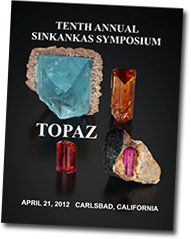 |
The tenth annual symposium in honor of John Sinkankas took place April 21 at the GIA (Gemological Institute of America) in Carlsbad, CA. The theme of the symposium was “Topaz.” Co-hosted by GIA and the San Diego Mineral and Gem Society, the event was attended by more than 125 people.
The printed papers presented at the symposium are now available for purchase from the symposium website. The specifications of the publication follow.
Photographs by Mia Dixon, John Koivula, Skip Simmons, Orasa Weldon and Robert Weldon
Table of Contents
Availability: April 21, 2012
Cost: USD $20.00 + shipping (varies according to shipping options and destination)
Specifications: 8/5" x 11"; soft cover, 88p., 25 col. pl., 1 B&W pl., 9 diag. and tables
  |
| Apéritif, anyone? There’s nothing lovelier than the delicate sherry color of natural imperial topaz. At left, 5.48 tcw in a cushion-cut matched pair, Inv. #19880. At right, something a little larger: a 22.50-ct oval, Inv. #17513. (Photo: John McLean) |
A brief recap of the symposium and speaker biographies are available at the website.
Still available are:
See the website for tables of contents. [back to top]
Pala’s Will Larson reports this month on the inaugural Arusha International Gem, Jewelry and Minerals Fair, which was held April 26–29, 2012. (For more background on the show, see our April 2012 newsletter story.)
In his report, Will writes that even though the show opened a couple of hours late, there was no difficulty in making the rounds to the dealers. In fact, more exhibitors would have been welcome. Since the show took place only a gemstone’s throw from the famous tanzanite mines, Will and other foreign attendees took advantage of visits to both the mechanized and artisanal operations. The former turned out to be one of the largest for colored gemstones that Will had ever seen.
Read the full story, with several photos, here.
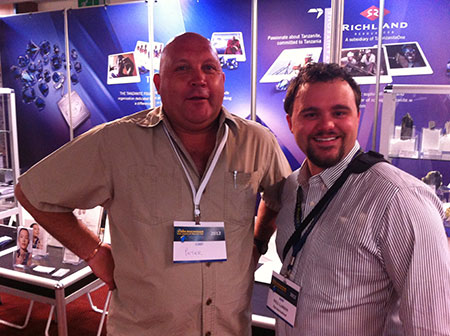 |
| Peter, mining manager for TanzaniteOne (aka Richland Resources), with Will Larson, right. (Photo: Bill Larson) |
[back to top]
As the months roll on here at Pala International, it becomes increasingly harder to come up with a suitable featured stone. We have logged about 100 featured items so far on Palagems.com. Sure, there are thousands of gem varieties and a plethora of colors bubbling out from our planet. However, to find a truly exceptional crystal created by Mother Earth, found by Man, and cut into a rare and beautiful gem worthy of display and intrigue... is an exercise in patience.
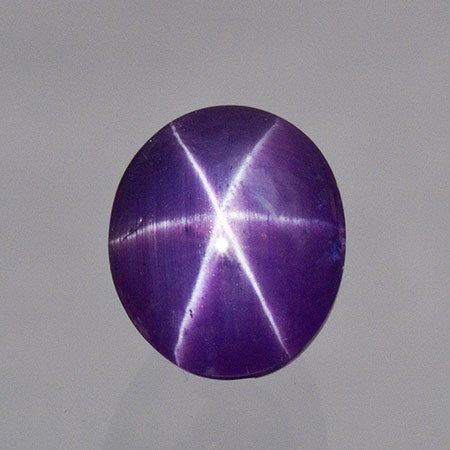 |
| Grape Asterism, 6.32 carats, 9.42 x 8.02 x 7.52 mm, Inventory #20268. (Photo Mia Dixon) |
This month we feature two new gems we purchased while at the Las Vegas show. First, a unique purple star sapphire from Sri Lanka. It’s an exceptionally fine star with sharp, full rays centered perfectly over the stone. The unique property is the grape-juice purple color that give the gem a candy-like feel.
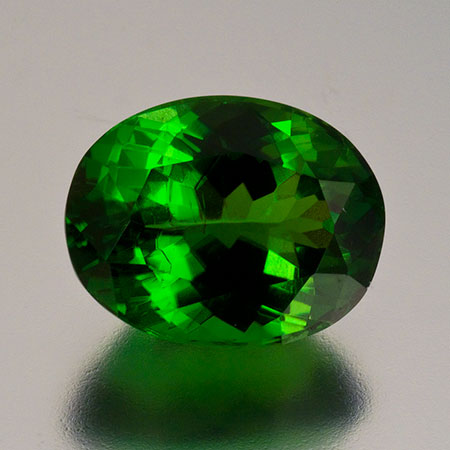 |
| Chrometastic, 5.75 carats, 12.33 x 9.7 x 7.08 mm, Inventory #20267. (Photo Mia Dixon) |
Another exceptional find in Vegas was this intense chrome tourmaline from Tanzania. It features a highly saturated evergreen hue with a pleasant medium-dark tone, brighter than most chrome tourmalines we normally see, since they can tend to be overly dark.
Interested? Call or email us to inquire.
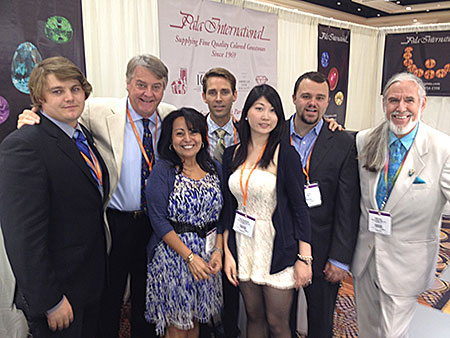 |
| Pala people at this year’s Las Vegas show. From left, Carl Larson, Bill Larson, Gabrièl Mattice, Jason Stephenson, Rika Nakamura, Will Larson, Josh Hall. (Photo: Rebecca Boyajian) |
[back to top]
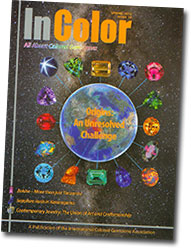 |
The recent Spring 2012 edition of InColor contains a fine follow-up to Thomas Hainschwang’s presentation on the problems of determining heat treatment in tanzanite given at the Gemstone Industry & Laboratory Conference (GILC) in February at Tucson. See “Zoisite – More than just Tanzanite” by Thomas Hainschwang and Frank Notari (GGTL Laboratories). (See also an overview of the presentation in this same issue on page 9.)
With their usual attention to detail and considerable finesse in explaining complicated gemological topics in a manner that is both clear and understandable to the lay reader, the authors give an overview of the gem varieties of zoisite. While most people are familiar with tanzanite, the blue/purple variety, many would be surprised to learn that zoisite is found in other beautiful gem-quality colors such as pink, green, yellow and orange. (See our featured stone for February.) The authors discuss treatment, pleochrosim and causation of color, pointing out that the latter natural colors react unfavorably to tampering. Look for more from these researchers in upcoming peer-reviewed scientific journals.
Another topic covered in the same edition is “Spinel and its Treatments: A Current Status Report” by Christopher Smith (archived at AGL). As Smith points out, spinel traditionally has been free of enhancement—until now. The article covers clarity enhancement as well as heat treatment at higher and lower temperatures. For an abstract of one aspect of treatment, see Shane McClure’s “The Identification of Heat Treated Spinels,” from the GILC website.
 |
| It’s a natural. This 6.26-carat unenhanced red spinel comes from Motombo, Tanzania. Inv. #20199. (Photo: Mia Dixon) |
[back to top]
Brian Cook of Nature’s Geometry takes us on a tour of three famous mining regions accompanied by some photos from geography to geology, from specimens to gems and jewelry.
Starting here in the U.S., Cook presents the two great tourmaline mining areas at the furthest extremities of the country, from the blue and green tourmaline of Maine to the pink tourmaline of Southern California. Then, heading south, we go to Brazil for the wild array of tourmalines, finishing with an in-depth look at the most rare and famous tourmaline variety of all… paraiba.
Access the PDF of the presentation here (13.4 MB).
 |
| Two slides from the presentation on tourmaline by Brian Cook. (Images courtesy Brian Cook) |
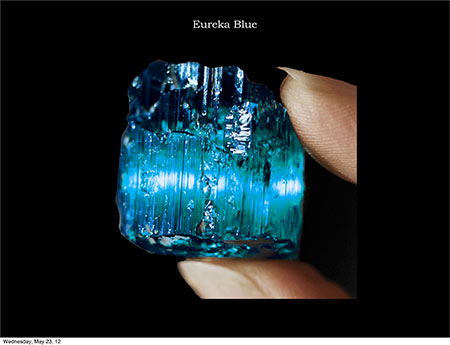 |
[back to top]
Christie’s Hong Kong Magnificent Jewels set a record on May 29 with the sale of a 6.04-carat cushion-cut Burmese ruby ring, designed by Etcetera. The pre-sale estimate of $2.6 to $3.9 million already seemed to put it in record territory; it sold for over $3.3 million. The “pigeon’s blood” color, with great purity and saturation, together with a high degree of transparency, made this a rare offering. The buyer was an anonymous private Asian.
The world record was for price per carat ($551,000/ct) for a ruby at auction. The previous record had been set during Christie’s sale last December of Elizabeth Taylor’s collection: $512,924 per carat—and it had taken five years for the latter record to overtake its predecessor, “The Graff Ruby,” at just under $422,000 per carat.
The catalog entry, which features a photo of the ring, included a quote from Jean-Baptiste Tavernier (of the famous blue diamond): “When a ruby exceeds five carats, and is perfect, it is sold for whatever price is asked for it.”
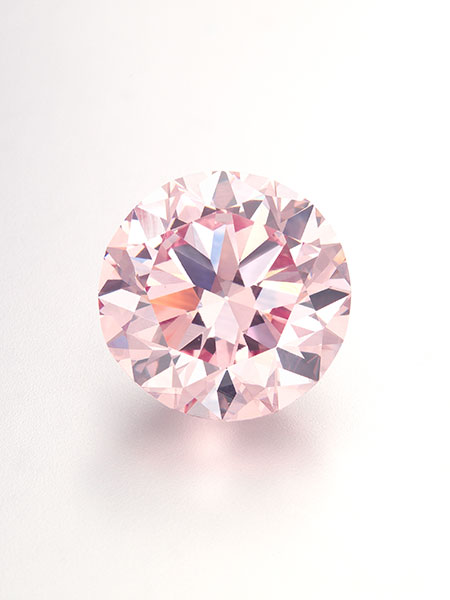 |
| There is life on Mars. A 12.04-ct fancy intense pink Type IIa round brilliant-cut diamond ring by Harry Winston. (Photo courtesy Christie’s Images Ltd. 2011) |
At the same sale, a colored diamond set a record just by being offered. The “Martian Pink,” at 12.04 carats, is the largest fancy intense pink diamond ever to appear at auction. In 1976, owner Harry Winston sold the stone to an anonymous private collector, but not before naming it in honor of the U.S. launch of the first satellite mission to Mars. The Christie’s news release states that
There are only two known significant sized round pink diamonds in this world, namely the Williamson Pink—a 23.60-carat beautiful pink diamond that was presented to Queen Elizabeth II on the occasion of her wedding in 1947—and the present 12.04-carat pink stone.
The release goes on to note that this stone is pure in its pink: not a trace of a secondary color. Such a rare stone comes at a price, but unlike the ruby above, the sale price of about $17.5 million was nearly double the low end of the pre-sale estimate of $8.4 million.
Namakwa Diamonds announced that the group had uncovered a rare 11.36-carat pink diamond along with a 44.47-carat diamond, both from its alluvial mine in South Africa’s North West Province, according to Proactive Investors (UK) (scroll down to see photo). In terms of rough per-carat value the two rank among the top five from the mine.
Graff Diamonds Ltd. is planning a $1 billion initial public offering in Hong Kong and as well as opening five new stores in Shanghai, Hangzhou, Hong Kong, Macau and Tokyo, according to a summary by Bloomberg of the company’s filing with the HK stock exchange. The company will be taking advantage of China’s luxury goods spending slice of the global pie, at 20%. But challenges to the plan also are outlined in the story.
[back to top]
We received the following trade alerts from the Ali Safar, Director of Directorate of Precious Metals & Gemstone Testing, Ministry of Industry & Commerce, Kingdom of Bahrain. They are printed with permission.
The oyster beds of the Gulf have been known for centuries as regular suppliers of pearls of great beauty and remarkable purity. These pearls have been known world-wide as “Basra” pearls and have been famous for their high luster and colors which range mostly from white to light yellow.
Recently, the Gem and Pearl Testing Laboratory of Bahrain (GPTLB) has been receiving quantities of strands and necklaces of pearls that are homogenous in luster and with an external appearance similar to Gulf pearls (Figure 1). Close microscopic examination of these pearls and analysis via x-radiography revealed that these pearls had natural structures, but different from the typical structures found in pearls from the Arabian Gulf. Further analysis on samples using the variety of laboratory advanced equipment, proved that these pearls were more likely to be from Pinctada maxima (silver-lipped pearl oyster) and not from Pinctada radiata (oysters fished in the Arabian Gulf).
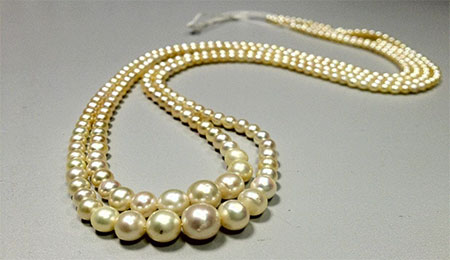 |
| Figure 1. A two-row strand of pearls treated to give an appearance similar to gulf pearls. (Photo: Ali Al-Attawi) |
Unfortunately these pearls once certified as natural pearls were sold in the market as natural “Basra” pearls with a value much higher than their actual price.
The GPTLB team is still researching the methods of treatment that have been applied to these pearls and is trying to find convenient methods of separating them once mixed in natural Gulf pearl necklaces.
The GPTLB has been set up to protect the market and authenticate natural pearls ensuring that cultured and man-made varieties do not find a place in the Kingdom of Bahrain.
Over the past two years the Gem and Pearl Testing Laboratory of Bahrain (GPTLB) has been encountering quantities of cultured pearls that have been beaded with natural saltwater pearls. These have mostly been submitted for reports as loose pearls or mixed in parcels and submitted as lots for sample testing.
Recently the GPTLB started receiving more difficult pearls. One of these was a drop-shaped light yellow pearl (wt: 3.60 ct). Externally the pearl had a bumpy pitted surface and looked normal. X-radiography of the pearl revealed an extremely faint void in the centre and a faint line at the thicker end of the pearl. Close examination of the internal structure provided subtle clues to its cultured nature (Figure 2). To be more certain permission was obtained to cut the pearl in half. Cutting this particular pearl was extremely laborious and difficult, and the surprise came when the real identity of the pearl was revealed after cutting. The pearl was beaded with a porcelaneous white pearl, most likely a lower quality Tridacna (clam) or pearl from some other mollusc species that could produce such pearls, i.e., conch, melo, etc.
 |
| Figure 2. Pearl cultured with a white porcelaneous pearl. X-radiography of the pearl reveals a faint demarcation at one end and an extremely faint void. (Photos: Ayoob Bahman) |
The GPTLB has also recently been receiving parcels of pearls of medium to high quality ranging in size from 8 mm to 15 mm. It was obvious that these pearls were most probably from Pinctada maxima (silver-lipped and gold-lipped pearl oysters) but with a lustre lower than that seen in the non-bead cultured (Keshi) pearls (Figures 3 and 4). Suspicions arose because some of these pearls revealed obvious structures via X-radiography, similar to those of natural pinna pearls, while others showed very fine lines with no distinctive demarcation and what appeared to look like dissolved structures. The pearls were X-rayed in several directions but gave inconclusive results as the structures were very confusing. Permission was given to cut two in half to prove their identity. This action proved that the pearls were products of cultivation by using natural pearls that had obvious natural structures apparently with the intention of confusing gemologists into certifying these pearls as natural.
 |
| Figure 3. X-radiography of a yellow pearl (Pinctada maxima gold-lipped oyster) revealed a faint demarcation on one side interrupted by a similar growth on the top of the faint demarcation. Cutting the pearl in half revealed a smaller natural pearl with an extremely fast growth on the outer layers. (Photos: Ayoob Bahman) |
 |
| Figure 4. X-radiography of a white pearl (Pinctada maxima silver-lipped oyster) revealed faint growth lines in the centre with no obvious demarcation. (Photos: Ayoob Bahman) |
The main problem with these pearls is that they provide identification issues when they are drilled and strung in necklaces and mixed with natural pearls. Their separation will be extremely difficult and care should be taken during testing. It is very obvious that these pearls will pose a great threat to the natural pearl market worldwide.
Strange Growth Patterns
The GPTLB has also been receiving parcels of necklaces with some of the pearls revealing strange growth patterns atypical of those usually seen in natural pearls. Some of these pearls have a hexagonal growth pattern extending to the edges rather than the more characteristic radial pattern seen in natural pearls. Rectangular concentrated growth patterns with curved edges have also been observed as well. These growth patterns have no relation to the external appearance of the pearls (Figure 5).
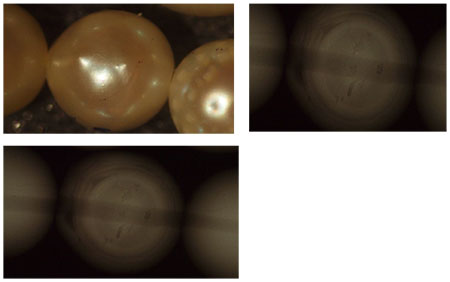 |
| Figure 5. Pearl strung in a necklace with a central calcitic core and a hexagonal growth pattern to one side. (Photo: Ayoob Bahman) |
The GPTLB team is still researching these pearls and trying to find convenient methods to separate these pearls, whether loose or drilled and strung in necklaces. The GPTLB works extremely hard to protect the natural pearl market in the Kingdom of Bahrain and adapts the most advanced techniques in the identification of pearls using X-radiography and micro X-ray tomography to assist in analyzing the difficult pearl structures that could be confused with natural pearls. [back to top]
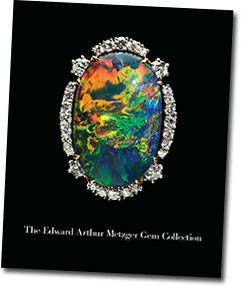 |
The breadth of the Edward Arthur Metzger collection is hinted at in the introduction to a new catalogue, which states that, while the late collector obviously had the resources to assemble a world-class collection, some of what he acquired “can be found in souvenir shops.” In his own brief essay that launches the book’s 400 pages, Metzger writes of communing with the inanimate—gauging its personality while examining its beauty as fate brings the two together—so, when he was called, he was called, not mindful of the pricetag.
The Edward Arthur Metzger Gem Collection, by William Bassett and Elise Skalwold, is the first of a two-part project that has been in preparation since 2008. The present volume documents the collection’s splendid elements with equally splendid photographs by Jeffrey Scovil, who imaged the majority of the most important members of the collection. Its future companion will delve into the stories and scholarship behind the collection—“the book that Ed Metzger desired and which I’ve been immersed in since 2009,” as Elise told us. Pala International’s Bill Larson is contributing to the latter, as we noted last summer, and it will feature more than 100 new photographs by Scovil.
In addition to its intended role in complimenting the future publication, Skalwold believes the broad scope of species and jewelry designs represented in this pictorial overview will be of wide interest, including to students of gemology and researchers alike. According to Dona Dirlam, Director of GIA’s Richard T. Liddicoat Gemological Library and Information Center, the volume has already been added to the library’s rare books collection, with a second copy available for circulation. Michael Coan of The Fashion Institute of Technology (FIT) in NYC also has expressed enthusiasm for the book’s addition to FIT’s library (see below). The Gemology certificate offered by FIT, under the direction of industry insider Coan, is now recognized by the State University of New York (SUNY). Skalwold herself is exploring ways to establish a gemology program at Cornell University, a long-time dream which is now partially realized with the completion of this present publication.
This catalogue is a handsomely produced coffee-table book that—at 10.25 x 12.5" and 6.6 lbs—just might test your table’s mettle. The front matter consists of a mere seven printed pages. So there’s no question of its focus: images of 871 gems, jewels and carvings spread between fifteen sections and a trio of “Organics” (ivories, pearls, ambers, fossils and corals), “Exotics” and “Other” (including enamelwork and watches). The concise captions for each piece are intentionally efficient, and belie the tremendous amount of research behind each one. This will become eminently evident with publication of the second volume; for a glimpse of the depth we can expect, see the authors’ article on Edward Arthur Metzger and his collection published by InColor in 2010.
We don’t need to say much more; you’ll want this in your personal collection, as indicated by the endorsements that follow. It will be available shortly through Cornell’s Johnson Museum of Art, and negotiations are in the works to make the volume available through Lithographie’s bookstore as well.
Below are some of the pieces whose personalities called to us…
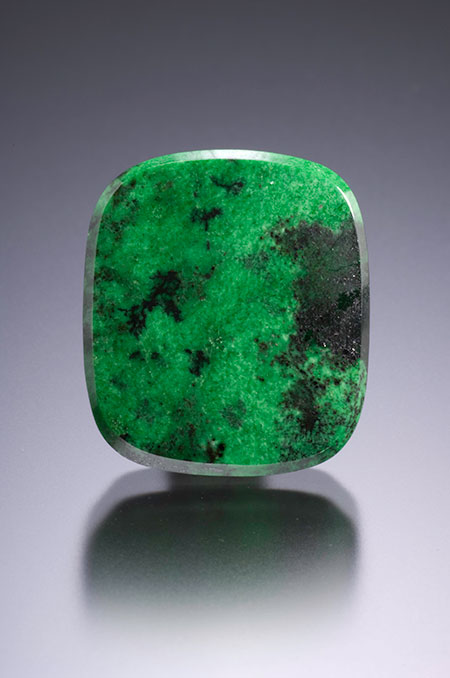 |
| Masquerading as maw-sit-sit, this hydrogrossular garnet is just shy of 15 ct, 18.88 x 15.58 x 3.66 mm. (Photo: Jeff Scovil) |
Dr. John Emmett: “DOWNRIGHT SPECTACULAR—The collection, but more importantly THE BOOK! The book is actually the more important of the two as it will document for all time such treasures and the book will be studied by more lovers of fine gems than will probably ever see the collection. What a major contribution. Please accept my praise for this fine work and also congratulate your co-author [Bill]. I cannot imagine how much work was involved in doing such a project….”
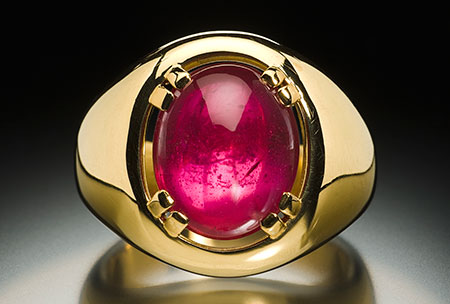 |
| Burmese ruby ring, 8.38 ct, 12.88 x 10.60 x 7.30 mm. The setting is by the late Claus Vollrath, who was Metzger’s personal jeweler and goldsmith. Vollrath and his wife Irma helped Metzger in assembling much of his collection. (Photo: Jeff Scovil) |
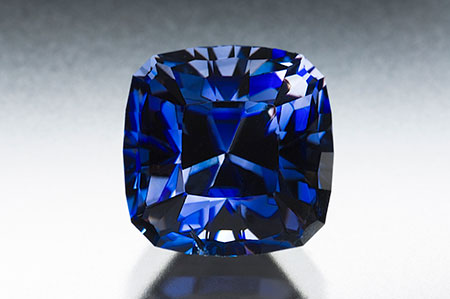 |
| Benitoite, 3.36 ct, 7.89 x 7.88 x 6.61 mm, included in the “Exotics” chapter of the book. (Photo: Jeff Scovil) |
John S. White: “…it is an impressive product, the color is great, and it clearly represents a ton of effort. I think you and Bill have every reason to be pleased with having brought this together. I can appreciate the amount of time and effort that must have gone into preparing this book, and I am very favorably impressed. Congratulations!”
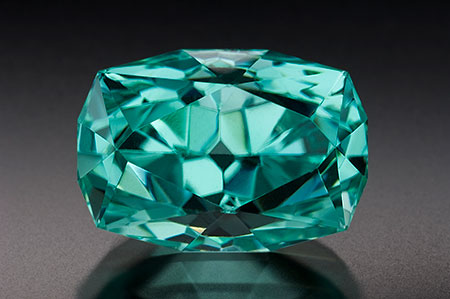 |
| Also from “Exotics,” this phosphophyllite, 10.99 ct, 14.77 x 10.30 x 10.28 mm, from Bolivia, likely the Unificada Miine in Potosí. In last summer’s article, Bill Larson commented on Metzger’s “rarefied predilection” for material such as this. (Photo: Jeff Scovil) |
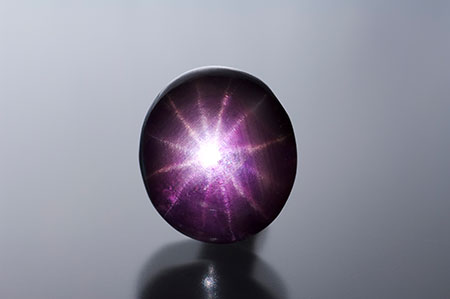 |
| Purple 12-ray star sapphire, 8.13 ct, 11.78 x 10.50 x 6.28 mm. Unlike this one, such stones often are glass-filled. For a brief report on the phenomenon, see “Twelve-rayed star sapphire of interest” by Garry DuToit, GIA Laboratory, Bangkok. (Photo: Jeff Scovil) |
Stephen Hofer: “…..the coffee table book on the EAM gem collection arrived today. It is beautiful! Jeff Scovil’s photos are magnificent. Ed would be very proud to see the stones he so patiently collected, displayed so well in a book. Although, if I know Ed, he would be most interested to hold a copy of the detailed “textbook” version of his collection. Ed loved the details, he loved to learn, and he was as inquisitive as ever, even up to his last days. Congratulations on what you and your colleagues have accomplished up to this point….”
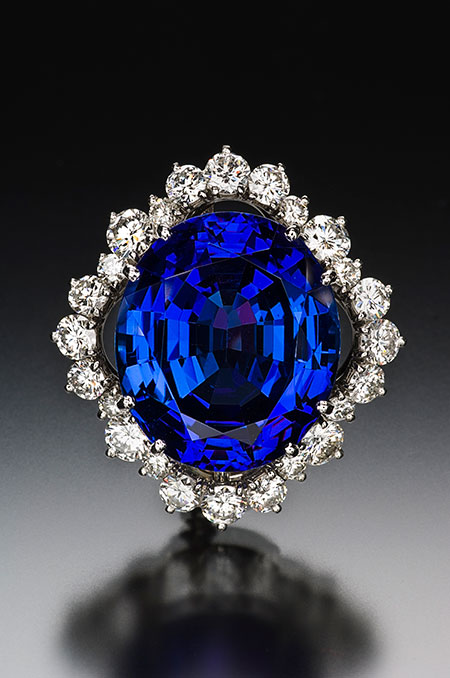 |
| Tanzanite and diamond brooch, 33.55 ct, 22.03 x 19.06 x 11.34 mm, in a platinum setting by Claus Vollrath. The diamonds have a tcw of 2.60. (Photo: Jeff Scovil) |
Michael Coan: “…[the book] will be a fine and valuable addition to our collection of jewelry and gem editions. Since this is such a visually oriented course of study, having a collection of work by Mr. Scovil, will be of great value as a reference tool as well. There is a sensitivity and dynamic feeling to the images and the general collection, and even in the few short pages that I have been privileged to view, these qualities come across immediately….”
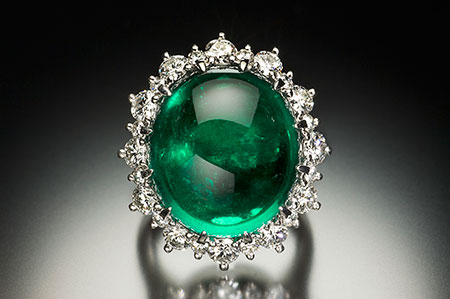 |
| This emerald and diamond piece may be worn as a ring or pendant. The emerald is 19.41 ct, 17.70 x 15.80 x 10.00 mm and is one of the few emeralds in the collection to be enhanced (clarity). (Photo: Jeff Scovil) |
Note: The hydrogrossular garnet above appears in the book in a different image. [back to top]
— End June Newsletter • Published 6/14/12 —
In this edition of our newsletter we globe-trot once more. Our featured stones come from Tanzania, site of last month’s fair in Arusha. We look toward shows in Vegas and Provence, and note a special day in Vicenza. We follow up on the temple treasure in Kerala, as well as sales in New York and Geneva. We look beneath the surface of pearls via SEM in a European lab, and beneath the surface of farmland in Sri Lanka, the jungles of Madagascar and the bluffs of SoCal. Finally, we list the remarkable moves following bi-elections in Burma.
 |
It’s time to plan for the JCK Las Vegas show. Pala International will be there in force, with one of America’s largest selections of fine colored gems.
Note: The JCK Show this year will run Thursday through Monday. The AGTA Pavilion will open the same day.
When: May 31 – June 4, 2012
Where: South Pacific and Islander Ballrooms in the Mandalay Bay Convention Center, Las Vegas, NV
Hours: AGTA Gemstone Section
Thursday, May 31 thru Sunday, June 3:
9:30 AM – 6:00 PM
Monday, June 4: 9:30 AM – 4:00 PM
Booth: AGTA Pavilion, booth AGTA514
We look forward to seeing our many friends there. Visit the Pala International Show Schedule for future events.
The GemFair will present four Gemstones and Pearls education sessions, including “A Closer Look at Colombian Emeralds: Passion and Profitability” by Ron Ringsrud. Also slated are Richard B. Drucker on “Top 10 Industry Issues,” Doug Hucker on “Successful Steps to Selling More Color” and Adam Graham on hosting “Gemstone Roundtable Events.” See this schedule for the full list of education tracks. And this list of GIA Hands-on Workshops. [back to top]
CIBJO, the World Jewellery Confederation, will hold its third annual gemological mini-conference, “Tourmaline Day,” on May 19, during the 2012 CIBJO Congress and the international exhibition of gold, jewelry, silverware, watches and gemstones, VICENZAORO, both being held in Vicenza, Italy. In the CIBJO press release, Dr. Margherita Superchi, who originally conceived of the annual conference idea three years ago, stated,
while tourmaline is gaining rapid recognition among jewellery retailers and consumers alike, there is relatively little attention paid to its gemmological aspects. The officers of the Gemmological Commission and I saw this as a great opportunity to help change this and we are proud to have found a distinguished panel of experts to present a set of fascinating lectures.
Presentations will be made by the following, stressing an intercontinental approach.
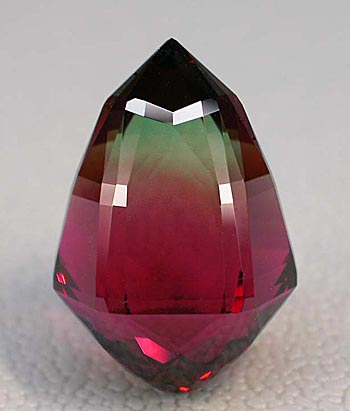 |
| This uncredited photo accompanies CIBJO’s announcement of “Tourmaline Day,” May 19, at the 2012 Congress. The bi-color tourmaline acorn was cut by Meg Berry, winning an AGTA Cutting Edge award in 1995. It was photographed by Wimon Manorotkul and sold by Gabrièl Mattice to a private collector. |
A pre-Congress report, issued May 9, by the CIBJO Gemmological Commission, announced that likely topics for discussion this year will be
diffusion of feldspar, the glass filling of rubies and the positions taken by laboratories on these somewhat controversial topics, not only among gemmological laboratories, but within the trade as well. Some technical updates may help to clarify the current situation and to support harmonisation.
[back to top]
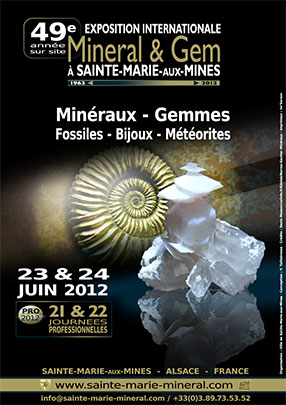 |
The Sainte-Marie-aux-Mines show has been through some changes since its inauguration in 1962. Then it was a small, local affair—a “day of mines.” Two years later the fair was entitled “Cailloux” (stones) and it attracted a regional audience. By 1966 it had become an “International fair of Minerals, Gems and Fossils.” While it originally was attended only by professionals—and professionals still enjoy their trade-only days—two days are now open to the general public. The show now attracts about 24,000 visitors and nearly a thousand exhibitors.
As we have noted before, 2012 was to see a major change in the show—a move to nearby Colmar. That was scrapped when other organizers decided to stay behind. So, at least for now, the show remains in the picturesque Alsatian village of Sainte-Marie-aux-Mines.
To get a taste, see:
This year, Bill, Will, and Carl Larson will attend the show along with friend and fellow gem dealer Mark Kaufman. They will follow that with a business trip to the gemstone center of Idar-Oberstein in Germany.
What: Mineral & Gem à Sainte-Marie-aux-Mines
When: June 21–24, 2012
Where: Sainte-Marie-aux-Mines, France
We look forward to seeing you there. [back to top]
Tanzania has been a hot spot for many gem varieties lately. Ruby from Winza, spinel from Mahenge, prase opal from Mt. Iyobo, sunstone from Masai Boma, and of course tanzanite from Merelani. Along with Bill and Will Larson’s trip to the Arusha International Gem, Jewelry & Minerals Fair they were able to buy a few select things. This month we feature a wild sunstone and unusual tanzanite to be plucked from the Tanzanian soil recently.
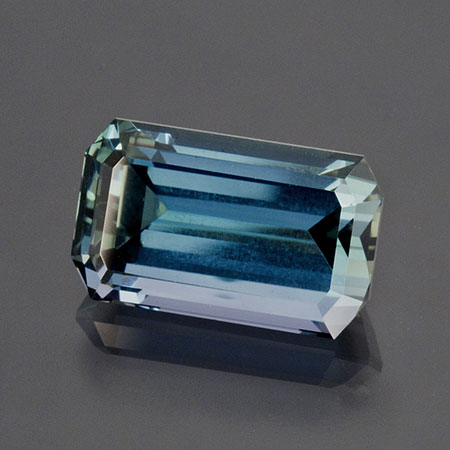 |
| Indigo blue tanzanite, 4.36 carats, 11.3 x 6.8 x 5.8 mm. (Photo: Mia Dixon) |
Merelani has continued to produce the world’s only source of gem quality tanzanite. Many millions of carats have found their way into the markets around the world since the late 1970s, but it seems the deposit has taken a turn and has been producing some more unusual jewels. We definitely have seen finer crystals and specimens being preserved as well as a variety of colors produced. We featured an amazing purple-pink faceted tanzanite a couple months back and now we have an intense steely blue-green emerald-cut that demands a second look. In a group of tanzanite, this unusual color stood out and earned a place in the Pala inventory.
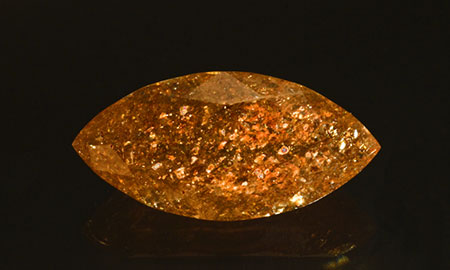 |
| Tanzanian sunstone, 19.53 carats, 27.50 x 13.47 x 10.27 mm. Inventory #20200. (Photo: Mia Dixon) |
The sunstone being produced out of Tanzania is very sporadic, with maybe a few kilos being unearthed occasionally. Most of the material seems to be heavily included and fractured. But every once in a while a large, fine stone like this one makes it out. This 19-carat marquise-cut beauty has a metallic copper sheen at first glance. Then, as you narrow in on the inclusions and start to rotate… the gem comes alive, throwing a full spectrum of colors from within.
See our previous featured Tanzanian sunstone here.
Things are looking very promising at the Mountain Lily Mine. A couple of weeks ago, Pala’s Jason Stephenson accompanied John McLean and Ben Castillo as they met up with Casey Jones to look at the positioning of the pegmatite at the mine. The heavily picked-through tailings produced reassuring results. Read about it in “Of Bluffs and Bees: The Mountain Lily Mine” on the blog.
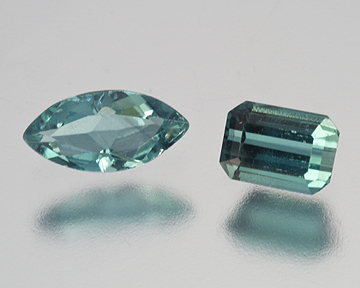 |
| Indicolites from the Mountain Lily Mine: marquise 0.46 ct and the emerald cut 0.56 ct. A gift from Jeff Swanger of the Ocean View Mine. (Photo: Mia Dixon) |
[back to top]
Editor’s Note: Last November, we looked at work being done by Biomineralix, an interdisciplinary network studying biogenic mineralization, and its application to natural pearls. This month, Ana Vasiliu, who contributed to that article, examines of pearl-to-host matchmaking.
Perhaps the best reason to look for the origin of pearls is curiosity. The classic method for this pursuit is finding a sufficient match between the pearl’s surface (skin) and a shell material. It does work, of course; done systematically, against the classic categories of shell fabrics—the interesting patterns of nanometer-scale crystalline units orderly packed in shell materials—pearl-to-host matchmaking is quite good enough. However, lists of shell materials do not show all that the partially understood mechanisms of mineralization deployed in shell growth can produce. [1] The odds of success might not be great for rebels; yet, intensely beautiful things frustrate pigeon-holing, their structure remaining difficult to name, beyond the repertoire of shells. Some are anonymous white-flame pearls.
Flame patterns on pearls run deeper than their exotic, translucent skin, as do structures responsible for the dance of light. [2] They have much to say about pearl growth, and the uncharted possibilities of their shell materials. It is unusual to see them unfolding throughout the body of a highly translucent pearl, however.
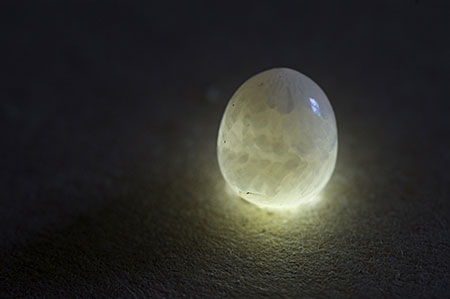 |
| Play of light reveals a three-dimensional spiral. Fanning sprays of aragonite laths spiral along the axis of symmetry of the pearl, not unlike the seeds of a pine cone. As, at some intervals, the alignment of laths becomes sufficiently tight, the material turns into relatively reflective sheets—the 3-D pattern seen easily by back-lighting these pearls. There are no discernible concentric growth bands hindering the three-dimensional spiral from filling up the volume of the pearl. [3] The same pearl is at the right in the next set of pictures. Click above to enlarge. See also: front, side, side, back. (Pearl donated for study by Stephen Metzler. Photos: Ana Vasiliu) |
On the surface of this pearl its building blocks can be seen at around 1000x magnification: laths (see caption above), no more than a couple of microns across and much thinner than wide. However, the internal arrangement is frustratingly inaccessible to all but destructive investigation. You’d have to destroy the pearl to see how the orientation, and perhaps variations in the size and shape of its building blocks, form the obvious pattern. If destroyed, would there be another like it? Perhaps no pearl is one of a kind in a significant way. There certainly are other examples close in appearance to the “pine cone” pearl above, and many more types of white, flamed pearls. However, the mineral fabric of such pearls delivers intriguing variations in the flame patterns—more so than one might expect from the tightly controlled patterns of shell materials.
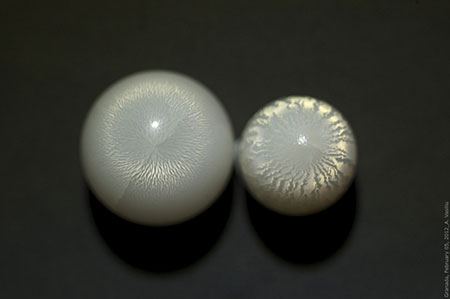 |
| Top down, the two “styles” of flame patterns appear closely related—the smaller pearl showing a stronger, bolder version of the larger pearl’s flame pattern. (Click to enlarge.) Turn them around (see view 2, view 3), and the story changes. (Photos: Ana Vasiliu) |
And yet, it is anything but easy to give a reason for the variety of pearl flame patterns. What makes the difference may only be a footnote in the process of assembly manipulating the crystallographic texture of minute, precisely matched fibers and laths of aragonite into the mineral fabric of pearls. Flame patterns are a lucky shortcut to charting long-range order in these fabrics. Studies of the corresponding shell materials suggest which rule may have been broken to get a pine-cone pearl out of well-behaved shell assembly, but the step is over a large unknown. [4] Since shell materials synthesis is somewhere at the frontier of current research, the pine-cone-like structure throughout the smaller pearl (above right) is difficult to associate with any more-or-less-related shell.
The prominently visible striped flame on the other pearl (above left) is easier to recognize: some cross-lamellar bivalve shells contain layers reminiscent of this pearl’s skin. Any of the Tridacnids could provide closely matched structural analogues. [5] Interestingly, the pearl fits the makeup of the second of three distinct layers found in such Tridacnid shells. And just as interestingly, the succession of layers in the shell is apparently not a must for pearl-making in this Tridacnid and other species of natural pearls, judging by the samples received for study so far. The perfectly precise switch between shell layers is somewhat of a mystery, with a fairly long trail in the academic literature. The feat of secretory specialization in some pearl sacs, producing only one of the materials otherwise deployed in precise sequence in the shell, shows another side of this modus operandi.
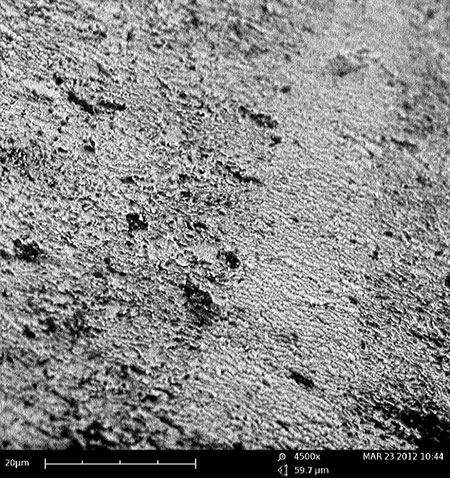 |
| Above: Scanning electron microscope image of the pearl at the left in the preceding photo. Bands are formed of tightly packed aragonite laths oriented at an approximately constant angle against the growth direction of the shell / pearl. From band to band, the laths dip in different directions. The SEM shot catches the sharp boundary between two such bands; in the lighter one laths dip away from the viewer. Below: Large, misaligned laths on another pearl with uneven mineral fabric and no flame pattern. The material resembles, if imprecisely, shell growth under environmental stress or shell repairs. [6] |
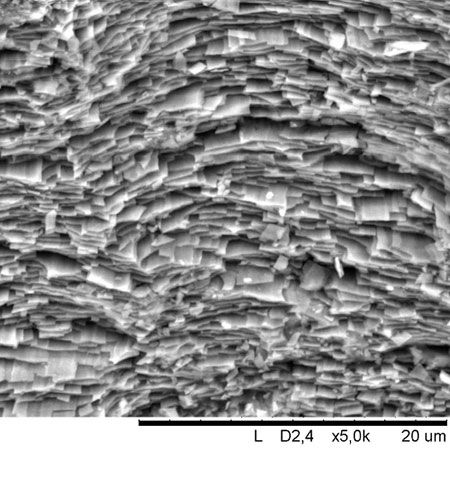 |
The SEM shot above might give a sense of the odds against fine pearls forming by different rules than the shell they are coming from: flame patterns depend on finely tuned long-range order in the mineral fabric. Disorder—such as among these laths, gives a pearl body with no play of light.
Note: Pearls were provided by Stephen Metzler and another private collection. SEM shots were taken at the the Department of Stratigraphy and Paleontology, University of Granada, and Biogeosciences, Université de Bourgogne, Dijon.
_____
1. See “Long-term evolution of shell matrices and microstructures: The bivalve example” in Frederic Marin, Gilles Luquet, Benjamin Marie and Davorin Medakovic, Molluscan Shell Proteins: Primary Structure, Origin and Evolution, Current Topics in Developmental Biology, Vol. 80, 2007, p. 260 (abstract here). [back to text]
2. H. A. Hänni. Explaining the flame structure of non-nacreous pearls. Australian Gemmologist, Vol. 24, 2010 (abstract here). [back to text]
3. There are no discernible concentric growth bands hindering the three-dimensional spiral from filling up the volume of the pearl, but this should not be surprising: some shell materials do not show prominent growth bands either. For reference, see note 4 below. [back to text]
4. For a description of the correspondence between crystallographic texture and fabric of cross-lamellar shell materials see Rodriguez-Navarro et al., Crystallographic relationships in the cross-lamellar microstructure of the shell of the gastropod Conus marmoreus, in Acta Biomaterialia, 2012 (archived here); and Nouet et al., Crystallisation in organo-mineral micro-domains in the crossed-lamellar layer of Nerita undata (Gastropoda, Neritpsina), in Micron, 2011 (abstract here). For a discussion of diversity in organic matrix components and mineralization, see Marin at al. cited above (Note 1) and D. Chategner, C. Hedegaard, H.-R. Wenk, Mollusc shell microstructures and crystallographic textures, Journal of Structural Geology, June 2000 (archived here). [back to text]
5. A. Yu Min Lin, M.A. Meyers, K.S. Vecchio. Mechanical properties and structure of Strombus gigas, Tridacna gigas, Haliotis rufescens sea shells: A comparative study, Material Science and Engineering, 2006 (archived here). [back to text]
6. C.A. Belda, C. Cuff, D. Yellowlees. Modification of shell formation in the giant clam Tridacna gigas at elevated nutrient levels in sea water, Marine Biology, 1993 (abstract here). [back to text]
[back to top]
If you subscribe to AGTA’s ePrism or Gems & Gemology, you’ll have seen a report of a “sapphire rush” on a Sri Lankan farm near the pilgrimage destination of Kataragama, in the southeastern part of the island nation. And you’ll have gotten the news of a second “rush”—of ruby and sapphire—in another island nation, Madagascar, near Didy, a farming area in the northeastern part of the country. (See Figure 30 in the first report for an illustration of the supercontinent Gondwana from which the two large islands theoretically might have emerged.)
Authors Vincent Pardieu, Emily V. Dubinsky, Supharart Sangsawong and Boris Chauviré issued the 82-page Kataragama report via GIA Laboratory in Bangkok on May 2. Shamil and Armil Sammoon, of Sapphire Cutters Ltd. in Colombo, first alerted GIA to the new find in late February. Earlier that month, the sapphire deposit is said to have been discovered by road construction workers. The story is, mm…, colorfully told of a dumptruck-load of earth on the road becoming “blue with hundreds of sapphire crystals.” Within hours ten to thirty thousand people were on the scene, clogging roads. But the earth actually was from a nearby peanut and chili farm belonging to a 23-year-old Mr. Ranga; sidebars recount his own stories. The National Gem & Jewellery Authority (NGJA) visited the area surrounding Mr. Ranga’s farm, which finally was determined to be the source, and ownership was transferred from the Forest Conservation Department to the NGJA, to facilitate division into 50 small mining lots.
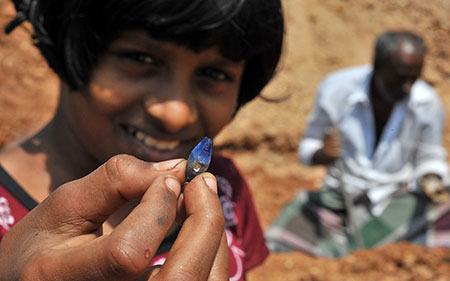 |
| On the road. A young Sri Lankan girl presenting a small sapphire she found on the road construction site near Kataragama. (Photo: Vincent Pardieu / GIA laboratory in Bangkok, © GIA) |
GIA Laboratory in Bangkok wasted no time in visiting. A team led by Pardieu arrived in the mining area on March 1, about the time when miners began to move onto their lots. The team’s visits to the mining site included following sapphire “hunters” who canvassed local houses looking for stones that might be worth buying. One can imagine the challenges regarding sanitation and machinery with 500 (mainly novice) miners populating 3.5 acres. And because the cleared land had no water resources, any promising soil had to be bagged, to be washed several kilometers away. Did Pardieu and crew have luck, in-situ? You’ll have to read the report to find out.
Several pages of the report are devoted to the geology of the deposit, with several more discussing field and market observations, nicely illustrated. Samples collected are then described, following study. The report concludes with a series of photomicrographs displaying the internal features of this new material. Access the full report here.
Whereas the Kataragama study is comprehensive, the Didy report gives a high-level taste of a larger publication to come. Following the sale in April of fine blue sapphires in Didy by gold miners and lumberjacks, authors Vincent Pardieu, Nirina Rakotosaona, Marc Noverraz and Lou Pierre Bryl traveled to the area on April 18. Although the deposit was located in the Ankeniheny–Zahamena corridor, which made it off-limits to mining, thousands of Madagascar miners and Sri Lanka buyers overwhelmed government agents in the jungle mining area.
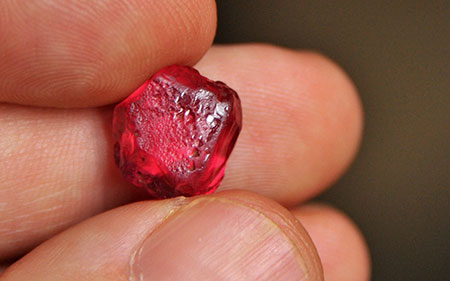 |
| Orangy red. The roughly 3-gram ruby shown here, reportedly from the new deposit, was seen in Ambatondrazaka. (Photo: Vincent Pardieu / GIA laboratory in Bangkok, © GIA) |
Rakotosaona, of the Société Minière du Cap Ltd. in nearby Antananarivo, the Malagasy capital, was able to avoid the ban on foreign visitors to the mining site, which teemed with between five and ten thousand people. The gem gravels were situated beside a stream, at a depth of less than one meter, as well as on the nearby hillside. Production included limpid blue sapphires, orangy pink sapphires and orangy red rubies—some with blue zones recalling material from Winza, Tanzania.
While in Didy and in the capital of the Alaotra-Mangoro region, Ambatondrazaka, the team saw several blue sapphires that were gem-worthy, weighing up to 4 grams, and were told of other fine crystals weighing up to 30 grams. They also were shown clean orangy red rubies up to 3 grams in weight, hearing of others weighing 5 grams. Samples obtained by GIA will be written up in the near future after study. (The present “teaser,” from which this information was taken, will become available to non-Gems & Gemology subscribers in the coming months here; for now, browse non-gemological photos from the expedition on Facebook.)
Pardieu also found time in March to “deal with some unfinished business” in Vietnam regarding blue spinels—part of a continuing, larger project dealing with rubies, spinels and pearls. This trip came after examining in the GIA Laboratory Bangkok two rough blue spinels obtained from a merchant in Vietnam’s northeastern district of Yen The in May 2009. The two highly saturated, vividly bright blue stones, upon inspection by GIA gemologist Sudarat Saeseaw, were determined to be a natural spinel and a tumbled synthetic. The source of the genuine spinel haunted Pardieu. Follow him and his colleagues on “Field Expedition 34: Vietnam Blue Spinels.” [back to top]
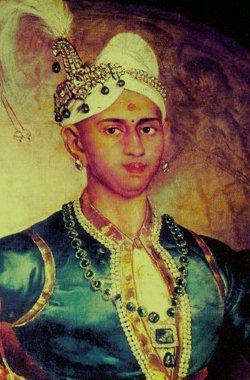 |
| Swathi Thirunal Rama Varma, Maharaja of Travancore (1829–1846), known as the “poet king” due to his compositions, musicianship and patronage. An annual festival is celebrated in his honor. Travancore royals administer the temple. |
When last we looked at the story of Sree Padmanabhaswamy Temple, the vaults of which appear to contain large quantities of jewels and antiquities, valuation of the treasure was to begin as early as last November 9. A week before that, however, the Kerala government named conservationist M. V. Nair as the new coordinator of the five-member Supreme Court committee for the temple. Nair already sat on the committee, and replaced former director-general of the National Museum, C. V. Ananda Bose. A few days later, the order designating the new coordinator was cancelled. Such is the bureaucracy that has delayed the valuation.
On November 30, temple security measures were unveiled: electro-hydraulic stanchions and other road blockers, bulletproof sentry posts, an armored vehicle, radio-frequency ID tags, surveillance cameras, one-person-only turnstiles, aerial surveillance, and blast-proof vaults. On December 25, it was announced that the temple’s old palm-leaf records were being digitized, in a process that was to take several months. A January 6 story claimed that inventorying would begin “soon,” but apparently would follow a February 15 court hearing.
On January 26, a dramatic television serial premiered, chronicling the legend of the temple. And set for June release is a “mystery thriller” film, Padmavyooham, which speculates on why the temple treasure was amassed in the first place. (Watch the trailer here.)
A provisional inventorying of the treasure was to be conducted on February 9. And it was. Utensils for rituals were photographed using 3-D cameras, undergoing X-ray fluorescence to identify the material, and bar-coded—a process taking a half-hour per item. Reports as to objects’ susceptibility to gases as well as size, shape and damage also were recorded. The prospect of future video capture of the items was mentioned. On February 20, gold items—but not jewelry—were documented.
A week later, The Hindu ran an op-ed piece about treasure fever taking hold of the country, with archeologists taking an earth-mover to a school and people digging under monuments to look for bounty. Inventorying at the temple was suspended on March 24 due to a festival, with resumption scheduled for April 16. On April 21, it was announced that “the large quantity of jewellery in vaults E and F… will be the first to be inventoried” when the process was to resume on the 23rd. Resume it did, according to the Times of India on the 24th. No reports have been published on the progress since.
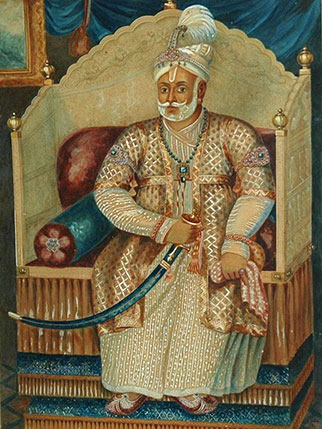 |
| Above, Maharajah (1758–1798) Dharma Raja, who is remembered for a savvy alliance with the British, infrastructure development, religious tolerance, and his own musical compositions and Kathakali plays. Below, Uthradom Thirunal Marthanda Varma, current patriarch of Travancore’s erstwhile royal family. Obviously, an emerald pendant is not languishing in vault E or F. |
 |
The temple has a new website, explaining that the structure was almost fully destroyed in a fire in 1686, with reconstruction starting only in 1724. In 1732 the idol of Sree Padmanabhaswamy, which was made of wood from the Iluppa tree (Indian butter tree, Bassia butyracea), was replaced with the present idol, consisting of an amalgam of 12,008 black ammonite fossils from Nepal’s Gandaki River, known as Saligrams for their association with Vishnu, covered with gold and precious stones.
See also these photos from The New Yorker’s photographer Chiara Goia. And the magazine’s subscribers can read Jacob Halpern’s Reporter at Large column regarding the temple. In the column, the temple’s executive, V. K. Harikumar, estimates the treasure to be worth at least $20 billion. [back to top]
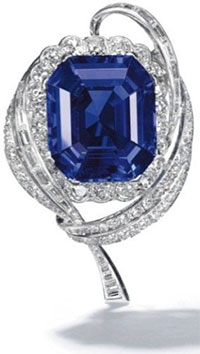 |
It’s been a month of record-setting at Christie’s. Yesterday’s Geneva Magnificent Jewels sale set two. A lovely sapphire and diamond brooch by Mellerio (lot 358, right) inched close to the price-per-carat achieved in New York last month (see “Two more…” below). The high-end presale estimate was $589,967, but it went for nearly six times that: almost $3.7 million—$77,500 per carat. It’s a record price per carat for a Burmese sapphire at auction. Laurence Graff was the buyer.
A 33.07-carat Kashmir sapphire ring (362) was to have brought in as much as $3.1 million, but didn’t sell.
An antique Indian emerald turban ornament, or sarpech, (369), which had an upper estimate of $1 million, went for $4.7 million to an anonymous bidder, after a “10-minute bidding war in the saleroom between two determined bidders,” according to Christie’s. That set a record, too, for an Indian sarpech at auction.
The top earner was a pair of Harry Winston diamond ear pendants (444), realizing $4.1 million, slightly above the high-end presale estimate. A diamond and colored diamond flower brooch was sold within its estimate range, at nearly $3 million. An emerald and diamond ring (197) sold for nearly nine times its high-end presale estimate.
On Monday, May 14, Christie’s offered The Hope Ruby, a 32.08-carat cushion-cut Burma ruby ring, pictured at left below as part of the charitable auction, Jewels for Hope: The Collection of Mrs. Lily Safra. Based on the action at last month’s sale in New York (see below), more record-setting was not unexpected. Thus The Hope went for far higher than its high-end presale estimate of $5 million, selling for $210,000 per carat—$6.7 million total—a world record for a ruby at auction. The ring had been in the collection of Luz Mila Patiño, Countess du Boisrouvray, whose daughter Albina du Boisrouvray is herself a philanthropist. In 1989, to fund her charity, Albina sold her jewelry collection, including (the then unnamed) The Hope, for $31.2 million at Sotheby’s New York—at the time a U.S. record for a single-owner sale. (The story of her twenty years of charitable work in Burma was told on March 17 in The Guardian.)
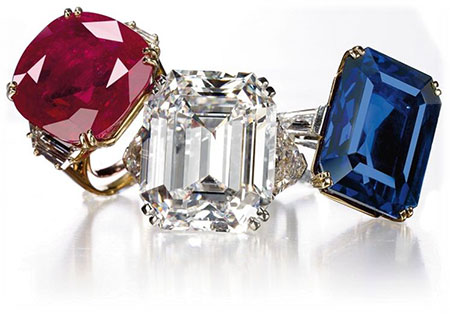 |
| Couleurs du drapeau. Three French settings frame the colors of the French flag. Left, is The Hope Ruby, designed by Chaumet, whose founder, Marie-Etienne Nitot, was Napoleon’s jeweler. Center, a potentially flawless 34.05-carat diamond, with a French platinum mark, hammer price $5.1 million. Right, a 31.21-carat Burma sapphire and diamond ring, in a setting by Boucheron, the first jeweler to move to Paris’s Place Vendôme. It fetched $676,588, or 25% more than the high-end presale estimate. (Photos: Christie’s press releases) |
The buyer of The Hope Ruby, which received its name from the title of the sale, was Amer Radwan of Dubai’s Radwan Diamond and Jewelry Trading. (Amer Radwan also picked up an important diamond necklace at the Sotheby’s sale, also in Geneva, naming it the “Dubai Vision.”) The entire sale set another record: world record total for a jewelry charity auction. The proceeds were to have been given to twenty charities, but twelve more have been added due to the nearly $39 million raised by the donor (see list here).
Two records were set during Christie’s New York Magnificent Jewels sale on April 17.
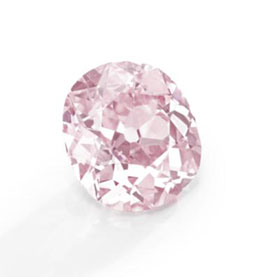 |
The Clark Pink, a 9-carat cushion-cut fancy vivid purplish pink diamond ring sold at $1.751 million per carat, more than doubling the high end of its presale estimate. Buyer Brett Stettner of Stettner Investment Diamonds told JCK he would have paid “far more.” Even so, the Clark Pink, to be renamed the Clark Grenald Stettner Pink (in honor of Stettner’s grandfather), becomes the most valuable pink diamond ever sold in the U.S. at auction.
The diamond was part of the estate of Huguette M. Clark, which Rahul Kadakia, head of jewelry for Christie’s Americas, called “the second most valuable private collection sold in the United States in the last decade, just behind the legendary jewels of Elizabeth Taylor.” With a presale estimate estimate of $9 million, the collection brought in $20.8 million.
A 31.53-carat sugarloaf Kashmir cabochon blue sapphire ring—not from the Clark collection—quintupled its estimate, selling for $84,300 per carat—the world auction record for a cabochon Kashmir sapphire.
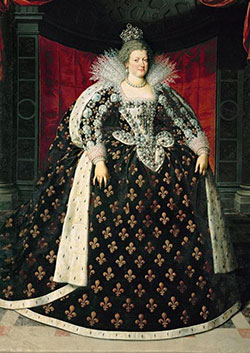 |
| Marie de Medici in coronation dress, portrayed by Frans Pourbus the Younger. |
Also in Geneva this week, Sotheby’s offered a hotly contested 34.98-carat diamond—the Beau Sancy—with a high-end estimate of $4 million. This stone has a story, and to tell it the auction house catalog devotes two dozen paragraphs between three writers. According to David Bennett, the stone was cut in the late 1500s, but in a way that was innovative for the time. Because of diamond’s hardness, making it difficult to cut, the Beau Sancy was among “the first attempts to liberate the ‘fire’ inherent in the stone—a property of diamond so familiar and so admired today.” Bennett declares that this particular diamond is sui generis: not before nor since has a precious stone allowed light to enter, reflect and disperse like the Beau Sancy. So the stone—once the property of Marie de Medici who wore it at her coronation—had five bidders upping the ante, according to AP. It sold to an anonymous party for $9.7 million. [back to top]
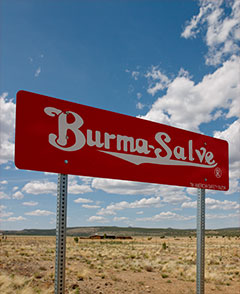 |
The last month was short on gem news out of Burma, but there was a theme that dominated…
On Monday, Senator John McCain called on the U.S. to suspend most sanctions against Burma. In a speech before the Center for Strategic International Studies on the topic of “Defining American Interests in Asia,” McCain’s prepared remarks included the following.
For the past year, I have said that concrete actions by Burma’s government toward democratic and economic reform should be met with reciprocal actions by the United States that can strengthen these reforms, benefit ordinary Burmese, and improve our relationship. Following the recent election that brought Aung San Suu Kyi and the National League for Democracy into the parliament, I think now is the time to suspend U.S. sanctions, except for the arms embargo and targeted measures we maintain against individuals and entities in Burma that undermine democracy, violate human rights, and plunder the nation’s resources. This would not be a lifting of sanctions, just a suspension. And this step, as well as any additional easing of sanctions, would depend on continued progress and reform in Burma.
For her part, Aung San Suu Kyi, speaking by video conference for a George W. Bush Institute event yesterday, said that McCain’s proposal “is a possible first step” and that she would not oppose such a move as long as the American people agree, according to AP.
This is a bandwagon of sorts:
 |
| Shiny Two Shiny. Two natural spinels from Burma in our Old Stock… New Pix section. Above, 4.45-carat cushion cut, Inv. #17363. Below, 2.58-carat oval, Inv. #2294. (Photos: Mia Dixon) |
 |
[back to top]
— End May Newsletter • Published 5/17/12 —
2015.3 | 2015.2 | 2015.1
2014.3 | 2014.2 | 2014.1 | 2013.3 | 2013.2 | 2013.1 | 2012.3 | 2012.2 | 2012.1
2011.3 | 2011.2 | 2011.1 | 2010.3 | 2010.2 | 2010.1 | 2009.3 | 2009.2 | 2009.1
2008.3 | 2008.2 | 2008.1 | 2007.3 | 2007.2 | 2007.1 | 2006.3 | 2006.2 | 2006.1
2005 | 2004 | 2003 | 2002 | 2001 | 2000
Note: Palagems.com selects much of its material in the interest of fostering a stimulating discourse on the topics of gems, gemology, and the gemstone industry. Therefore the opinions expressed here are not necessarily those held by the proprietors of Palagems.com. We welcome your feedback.